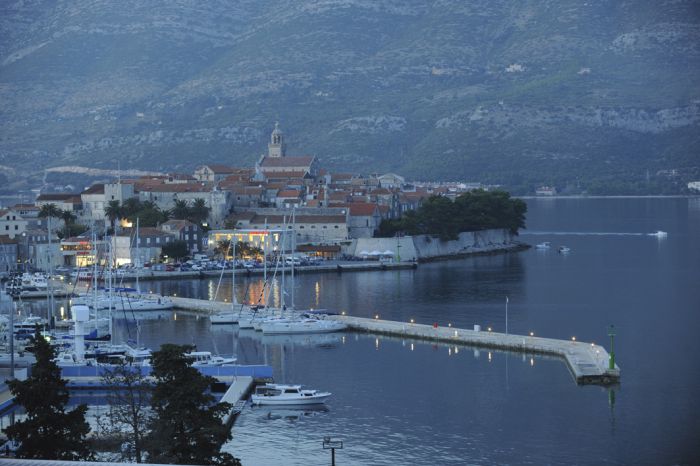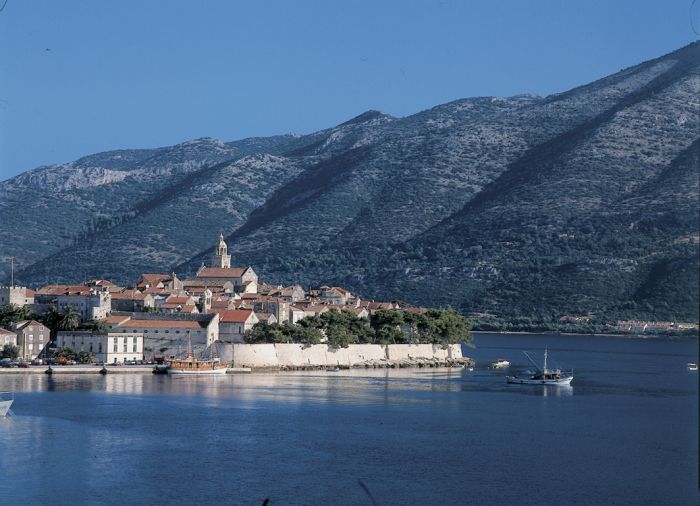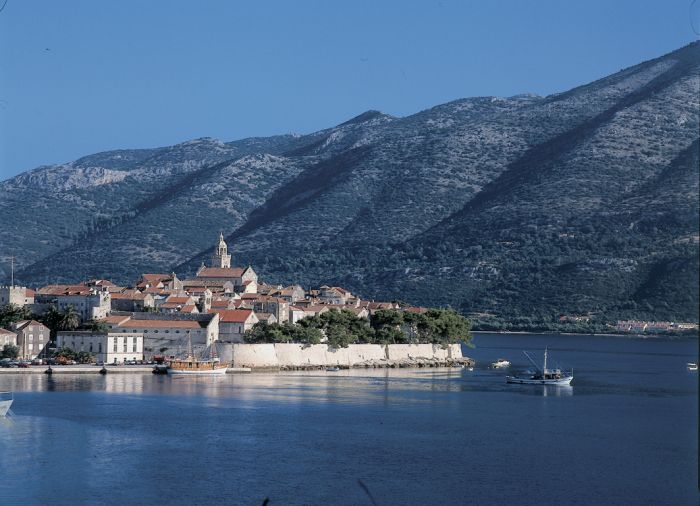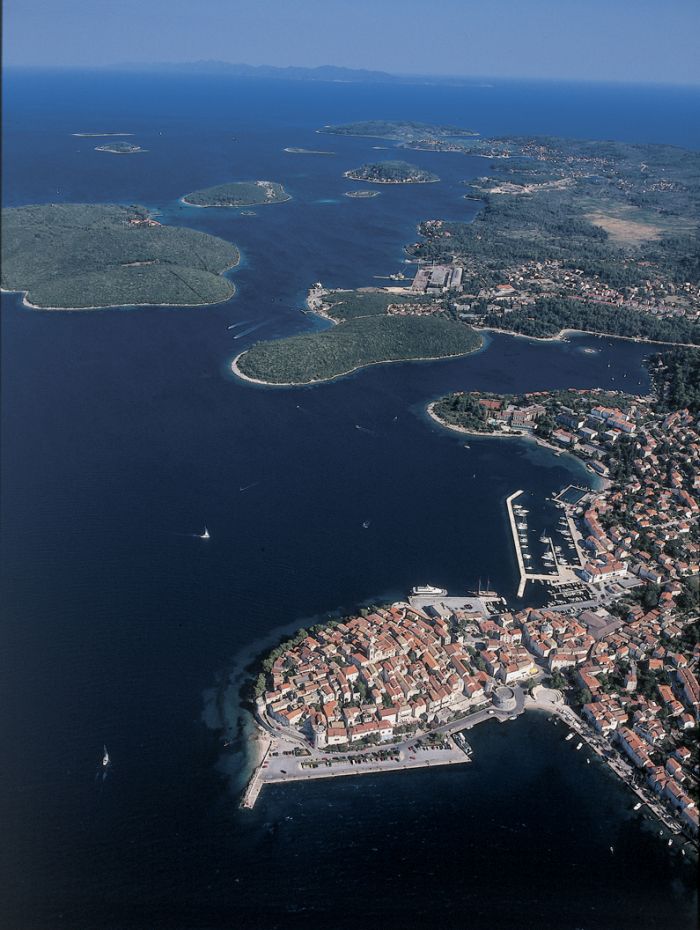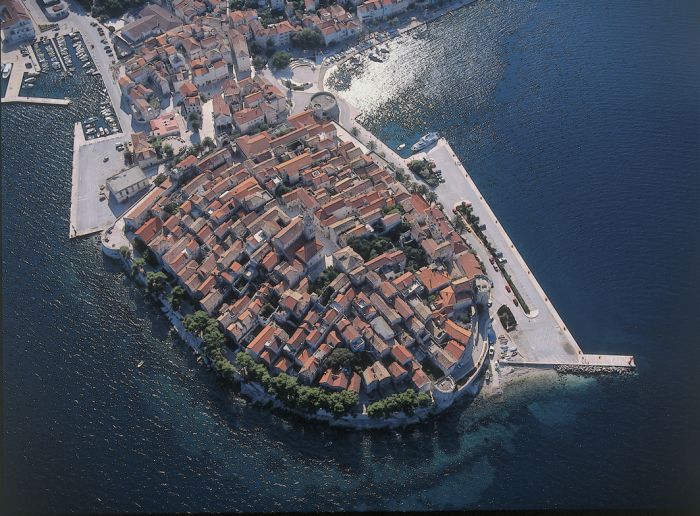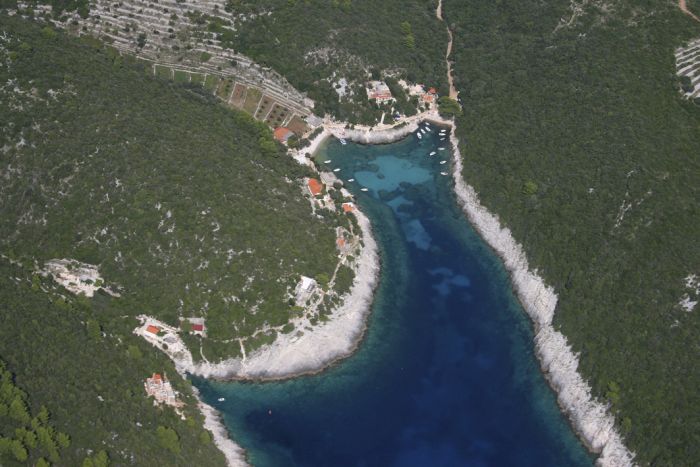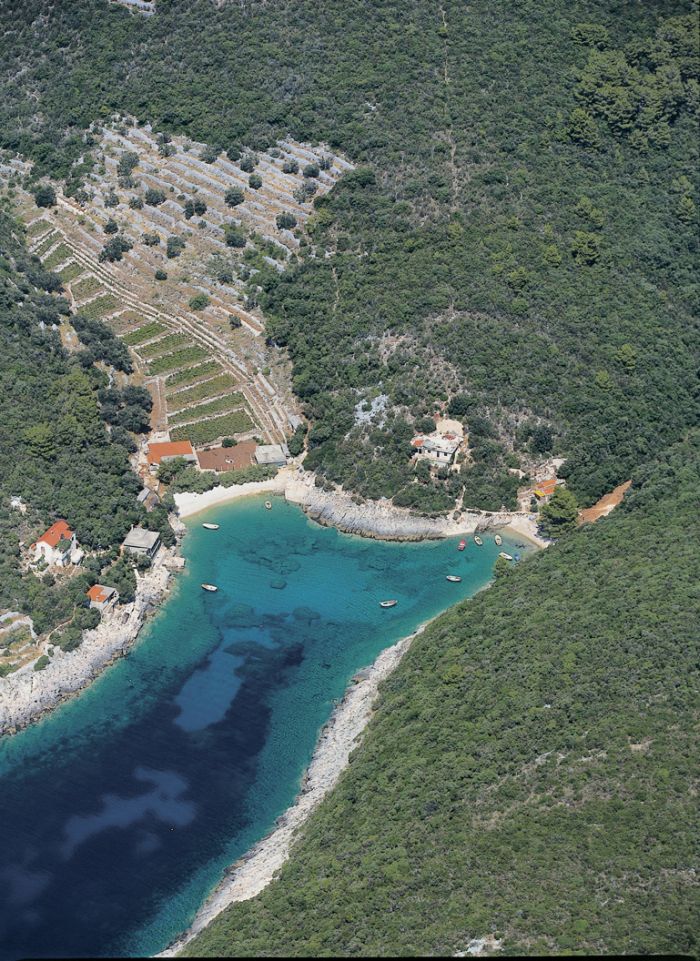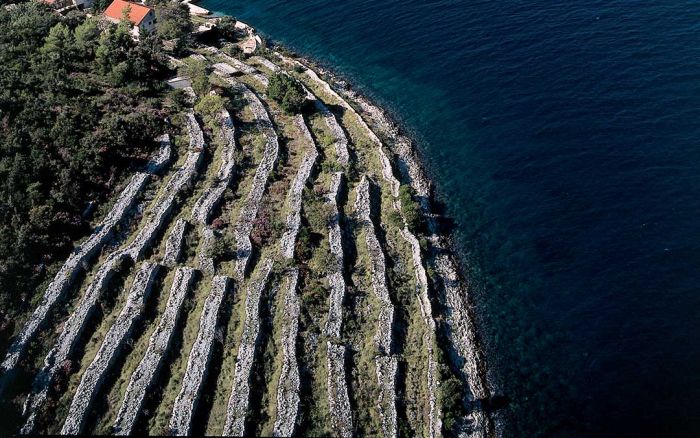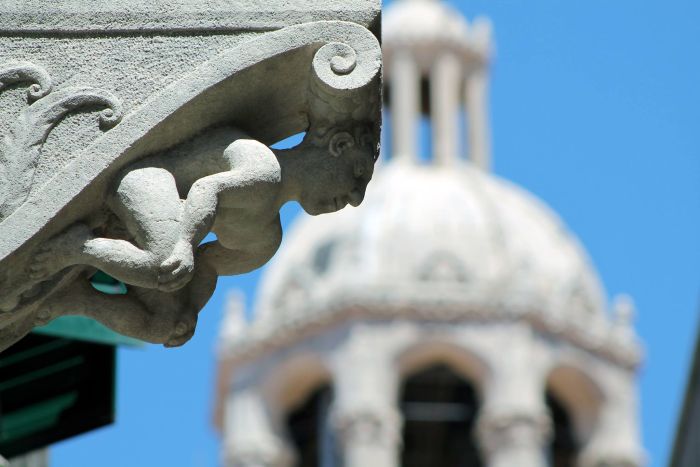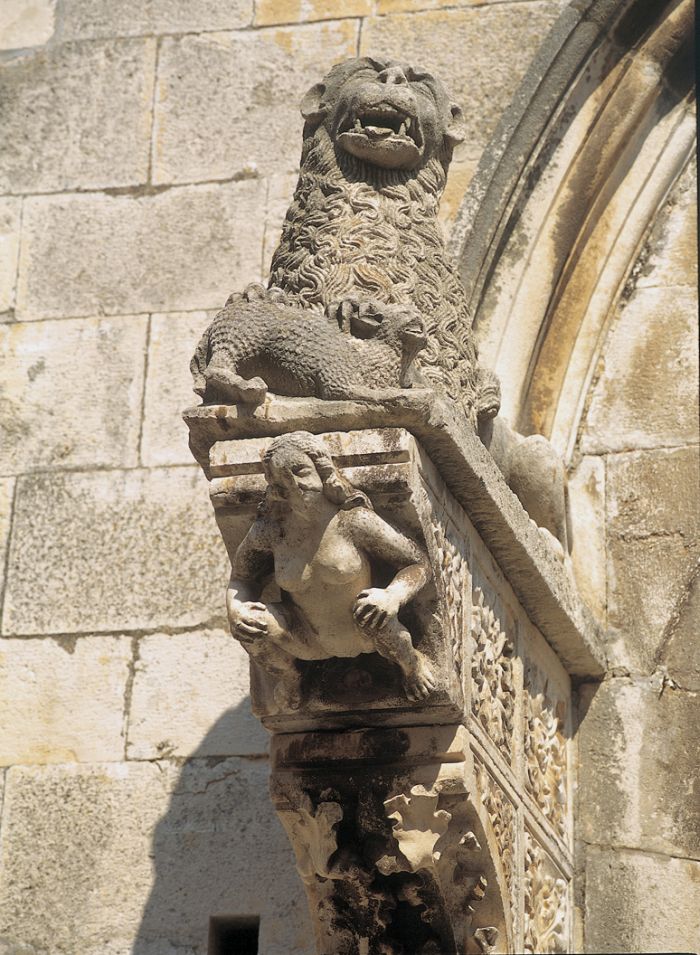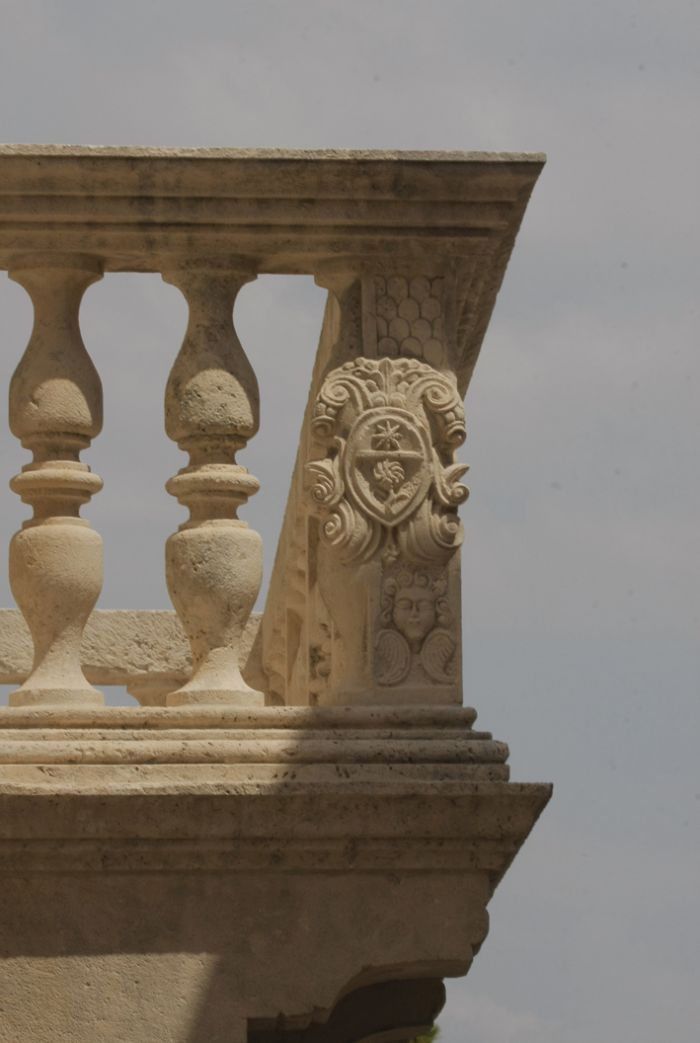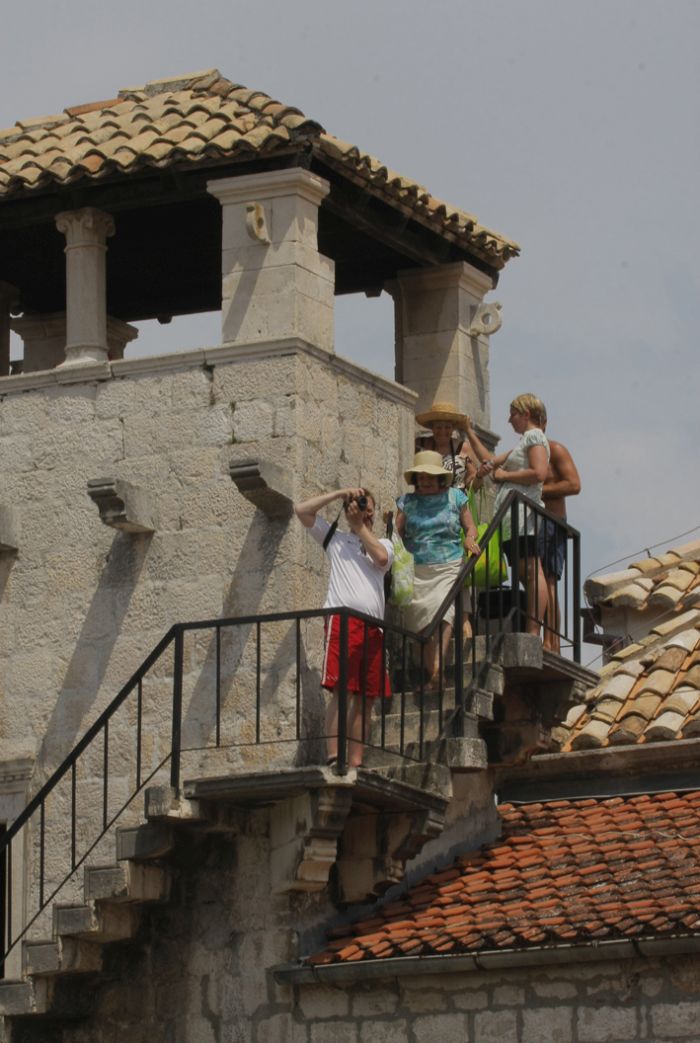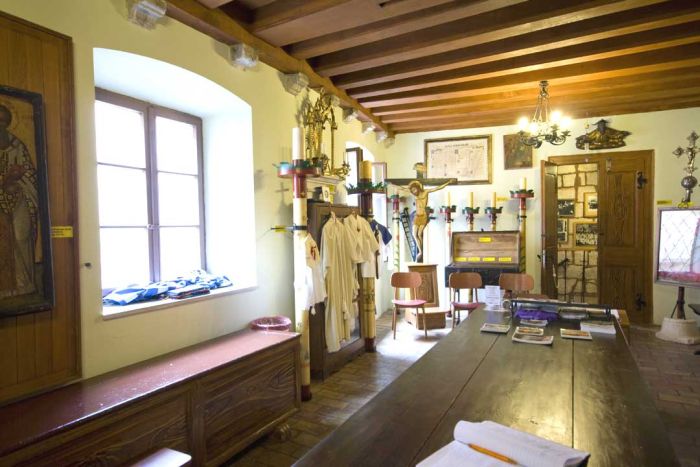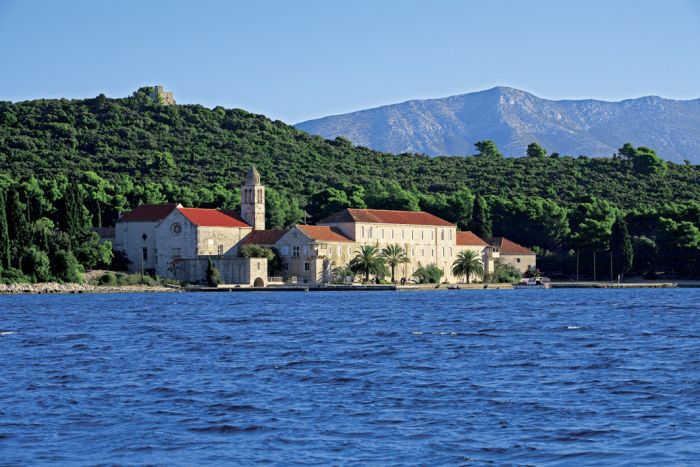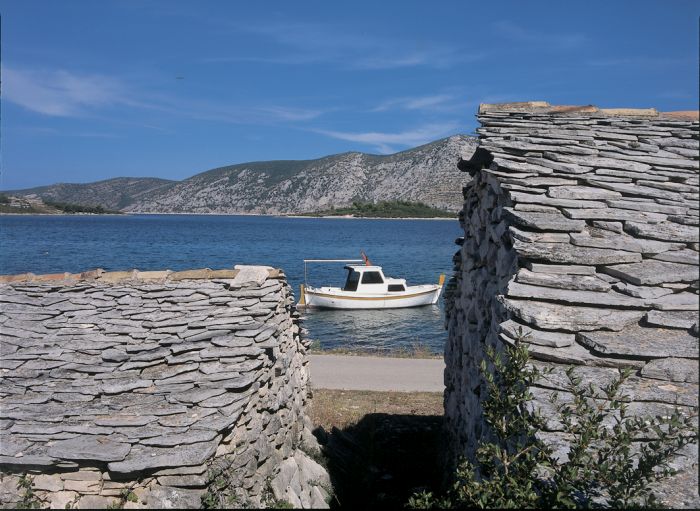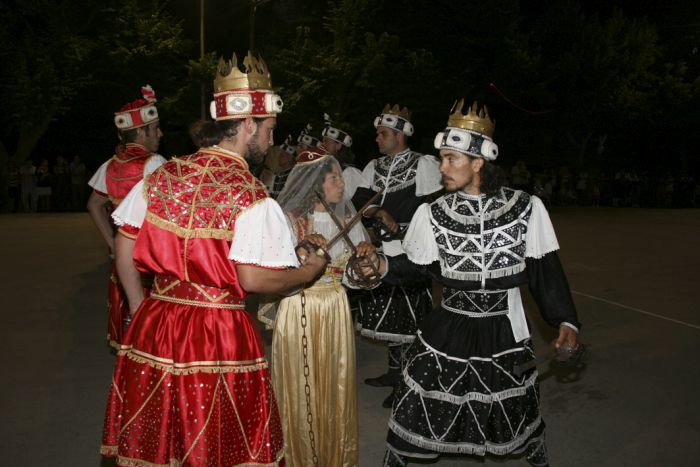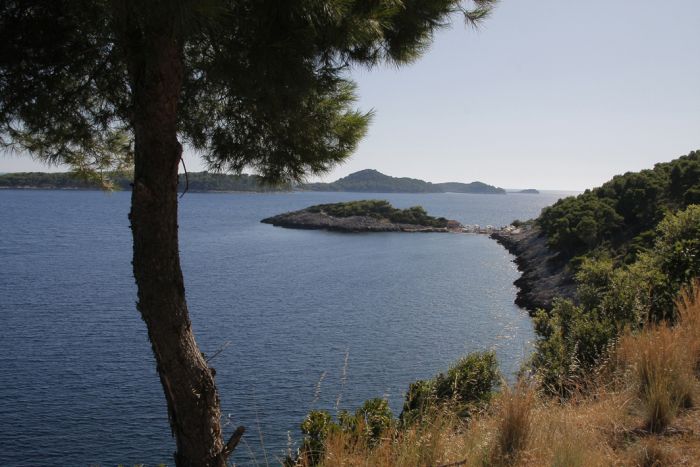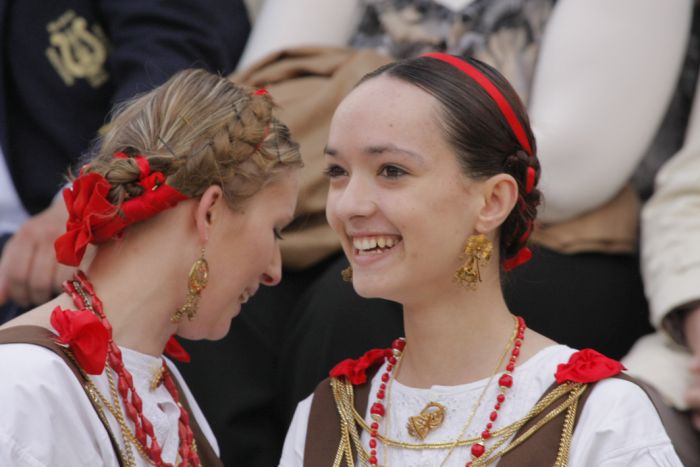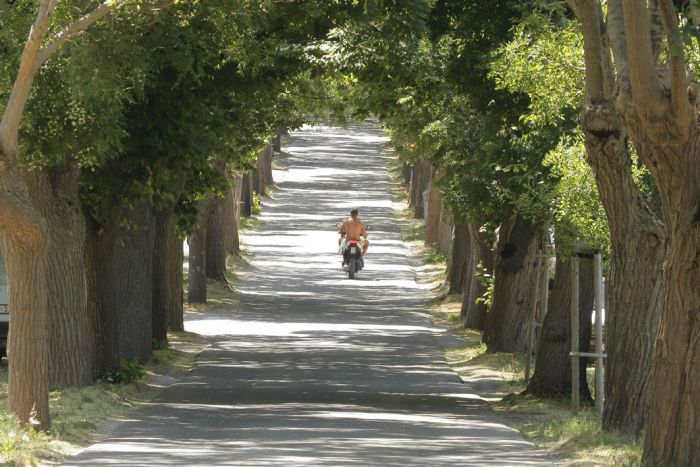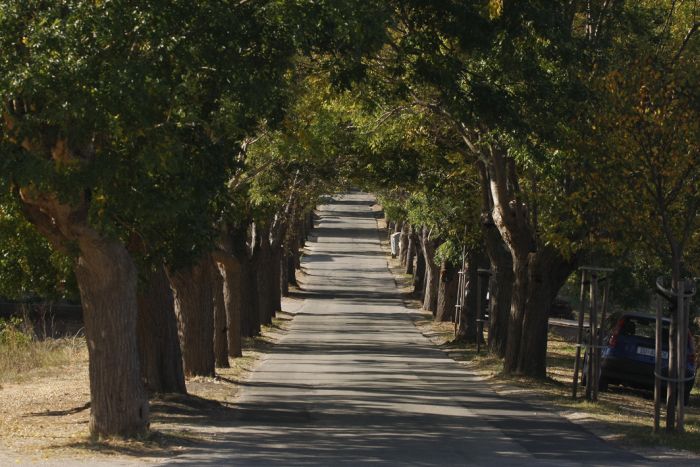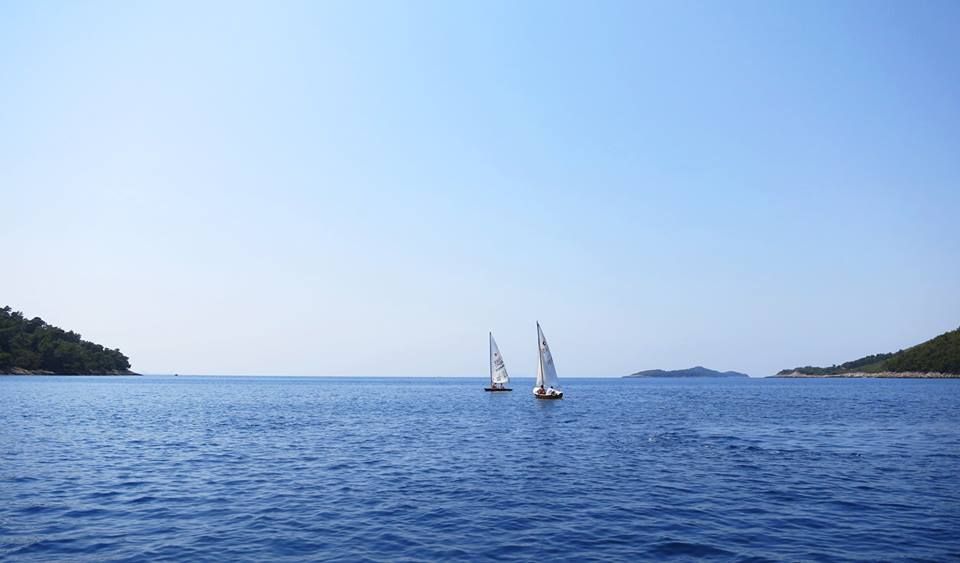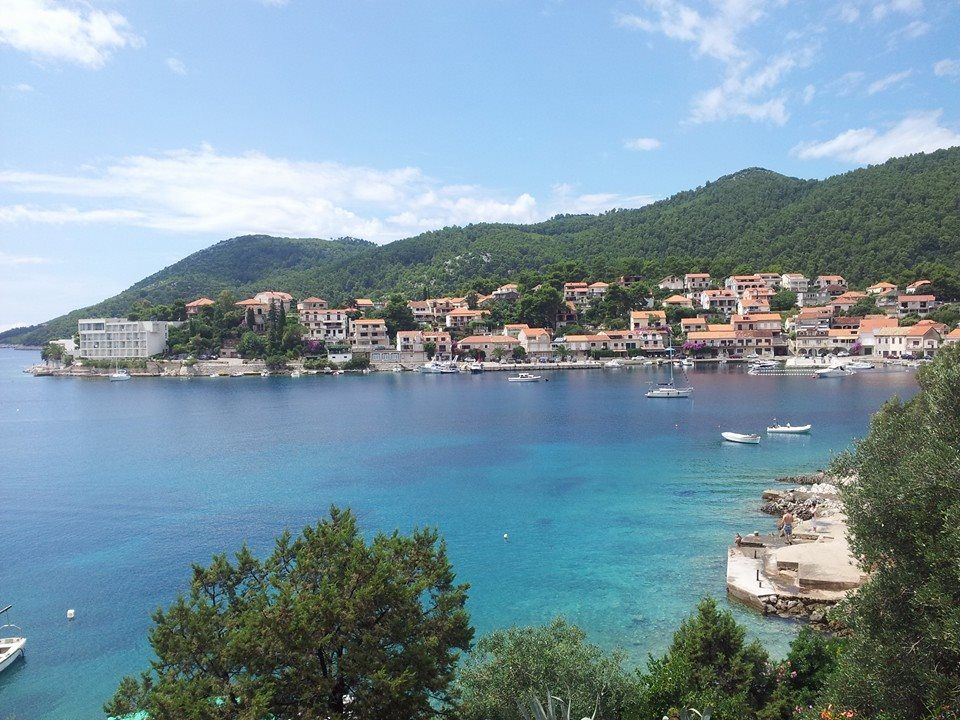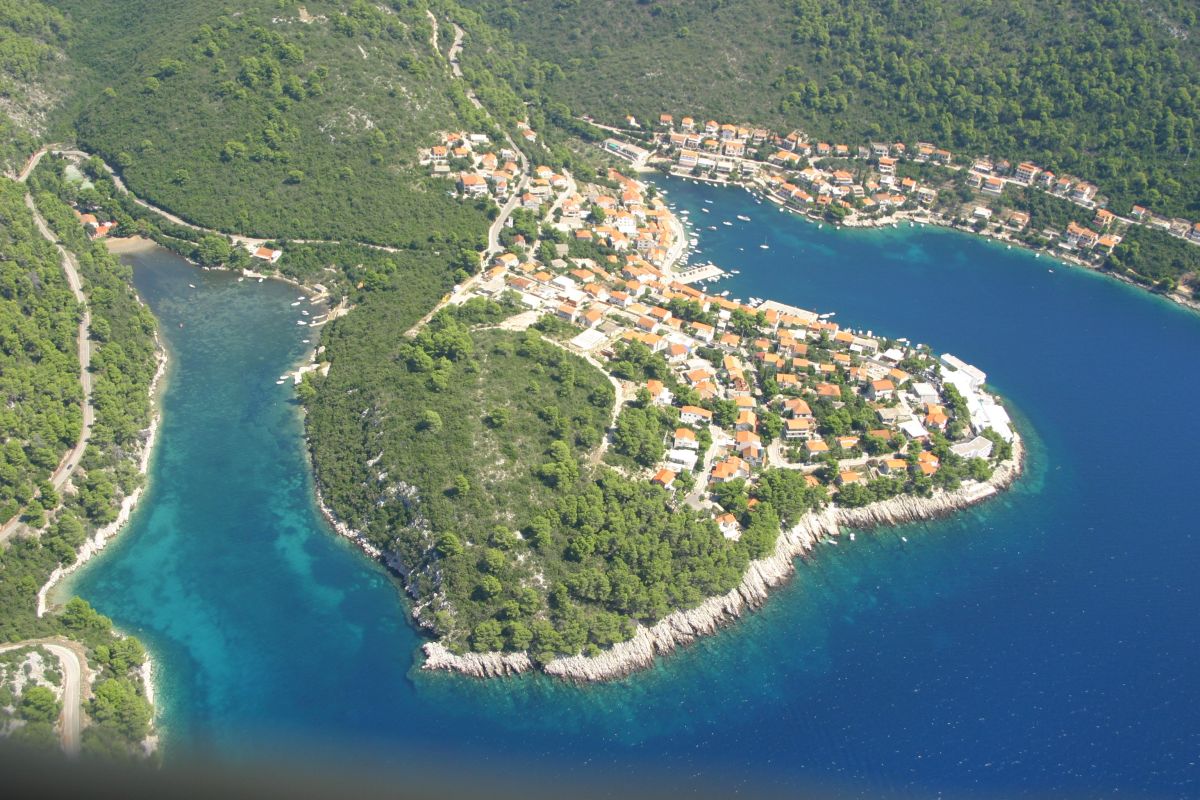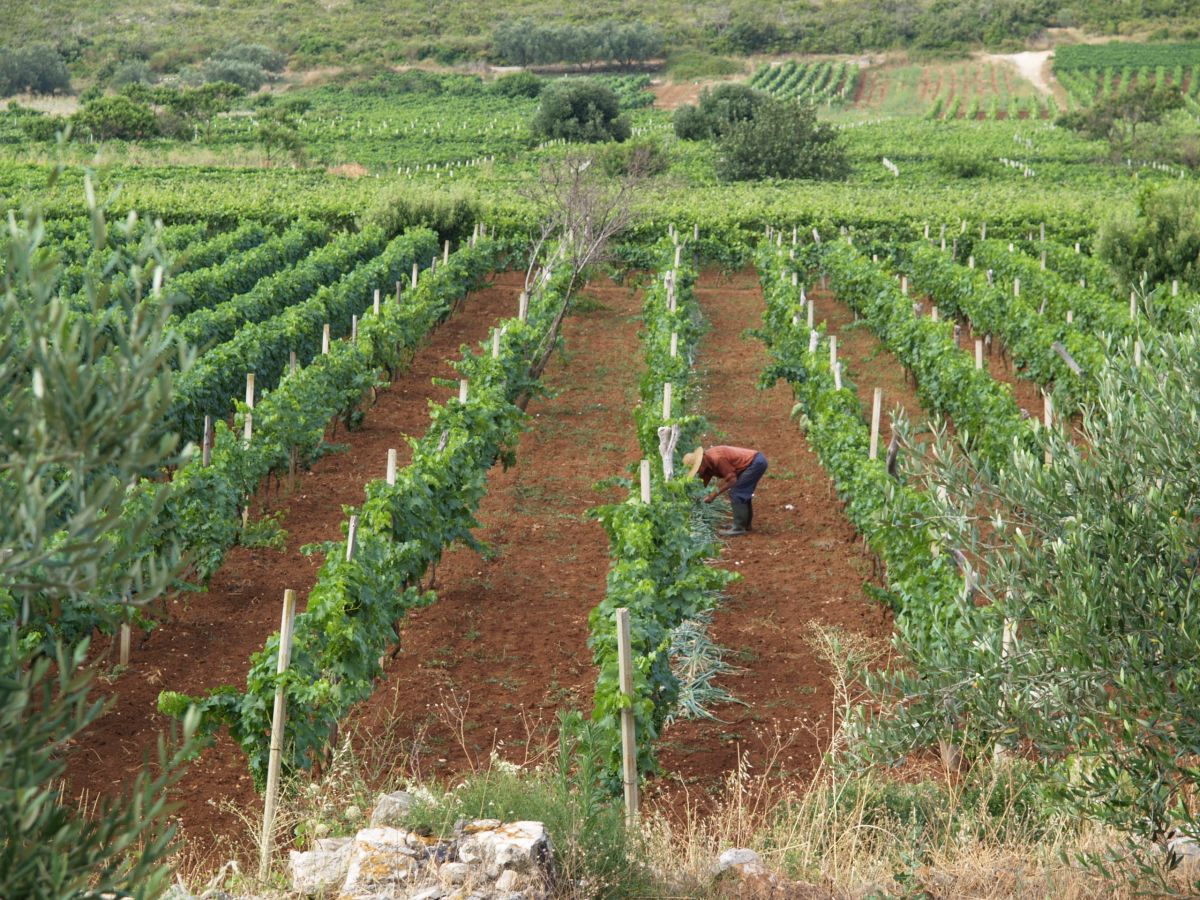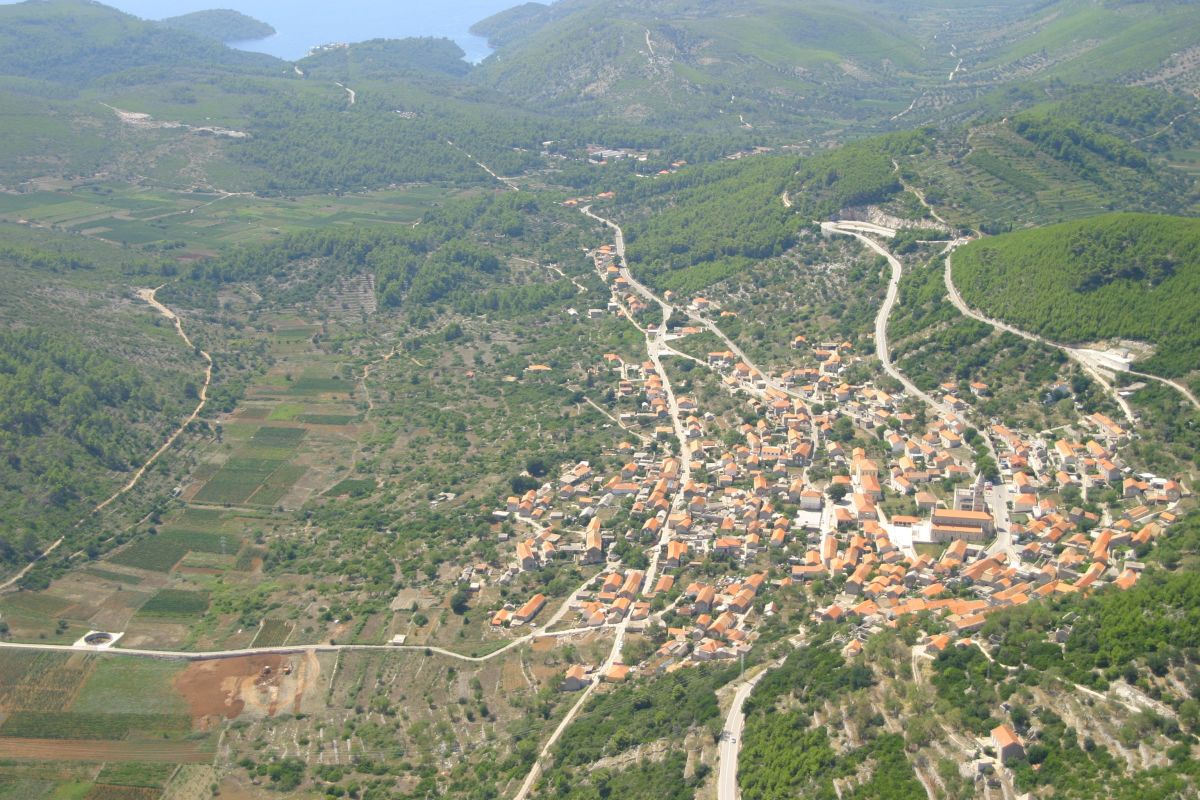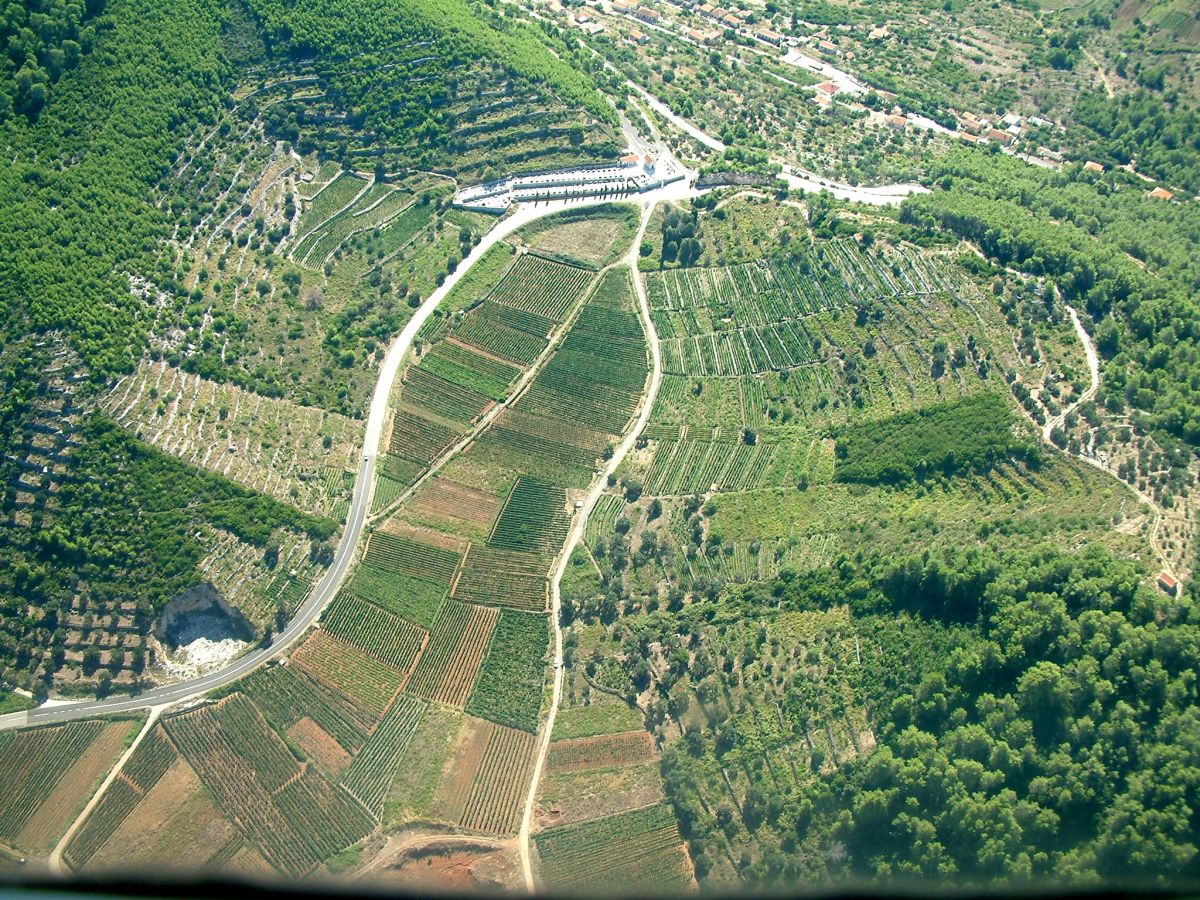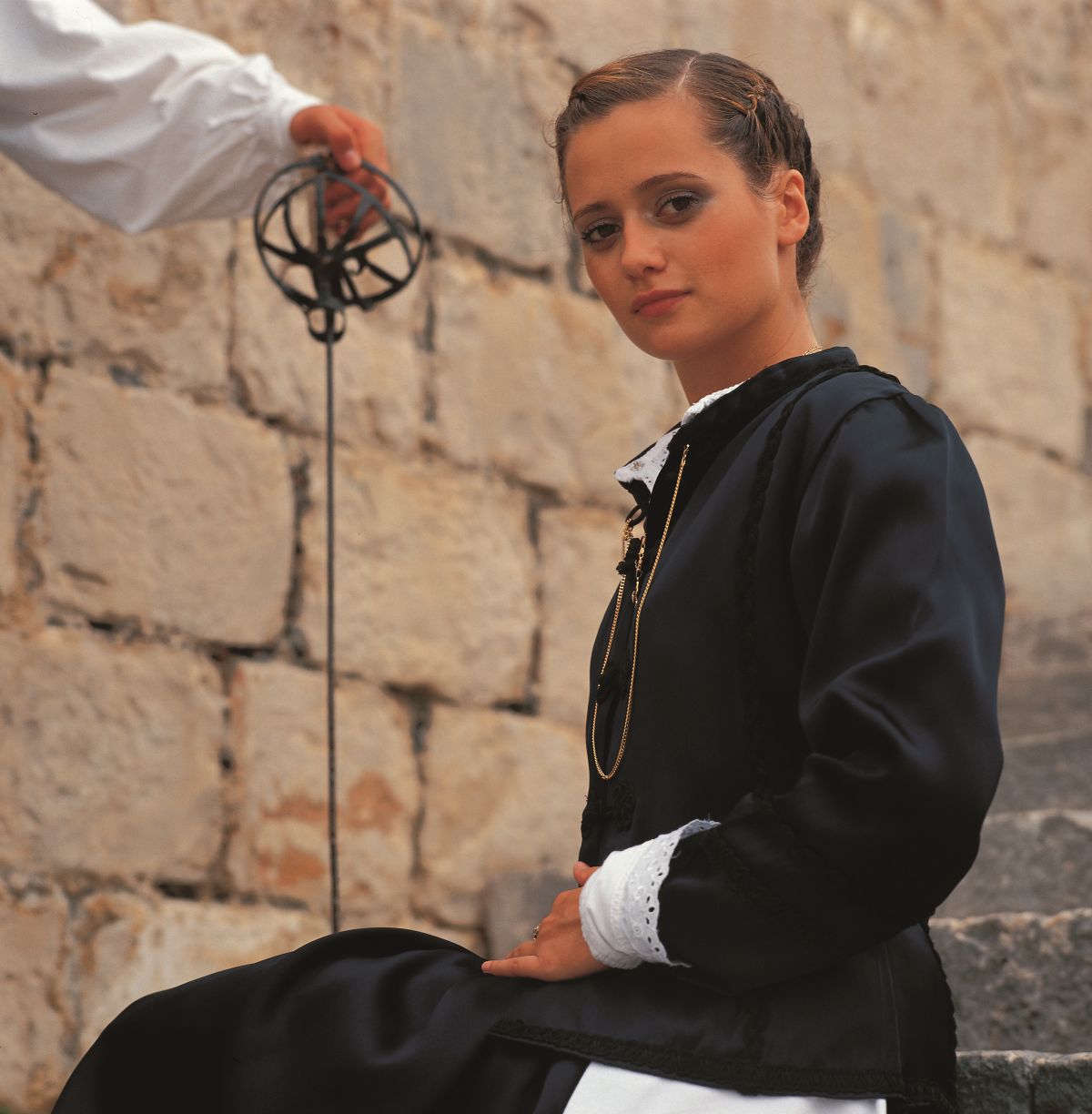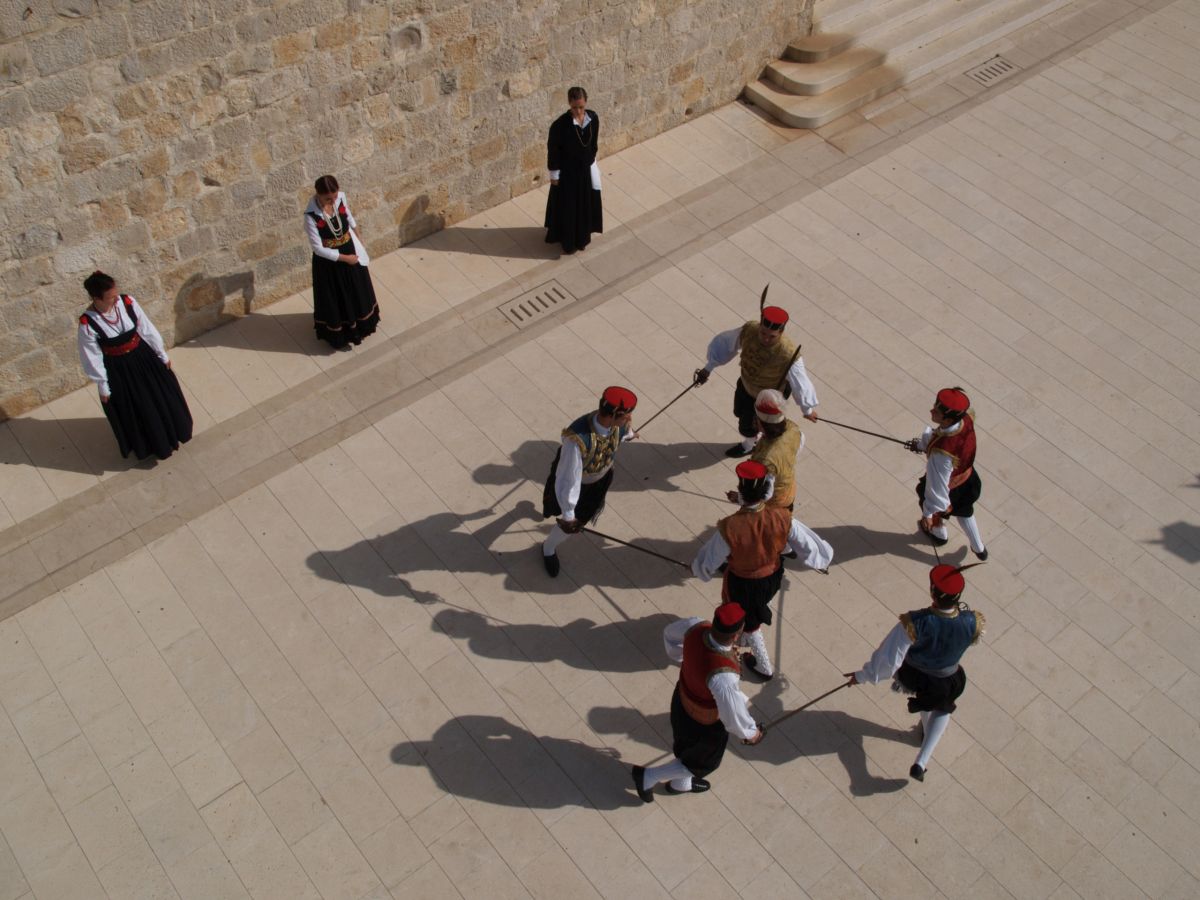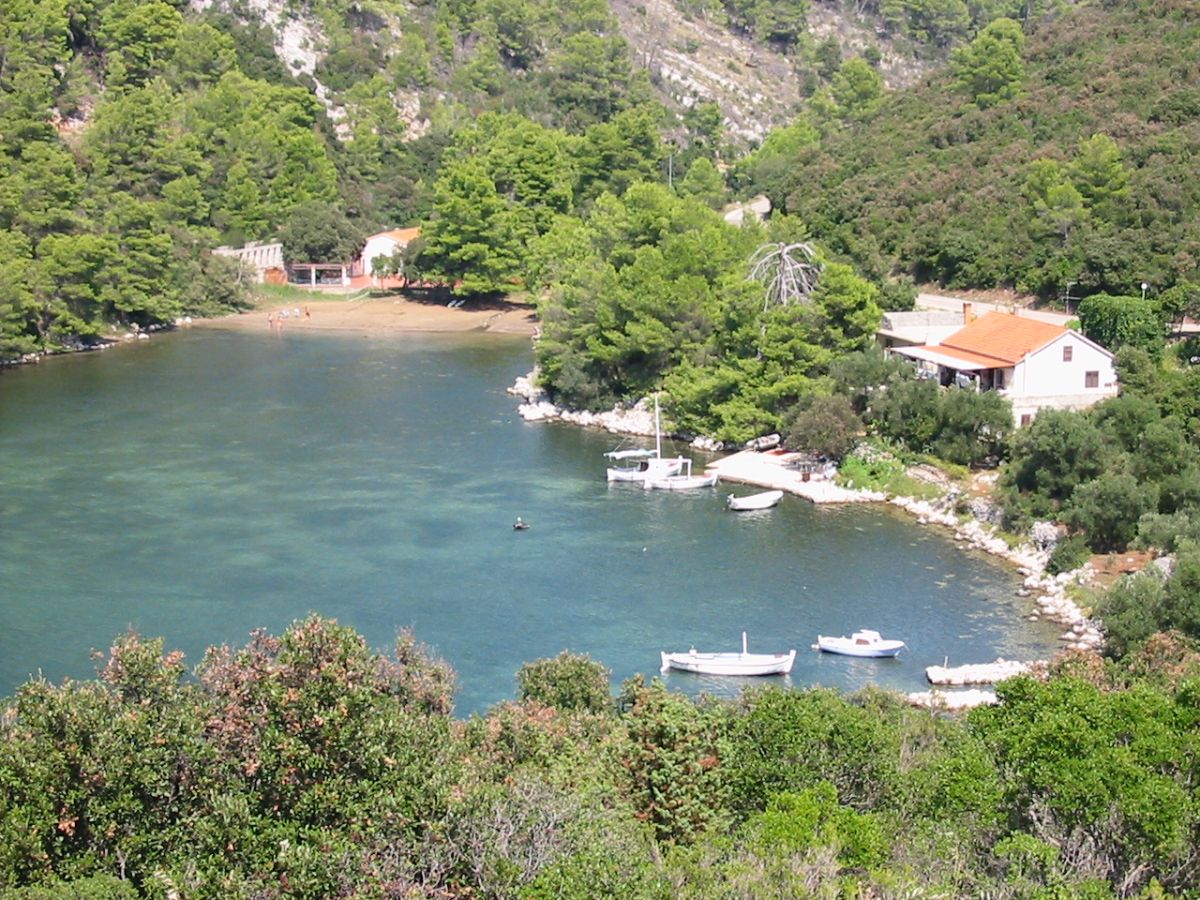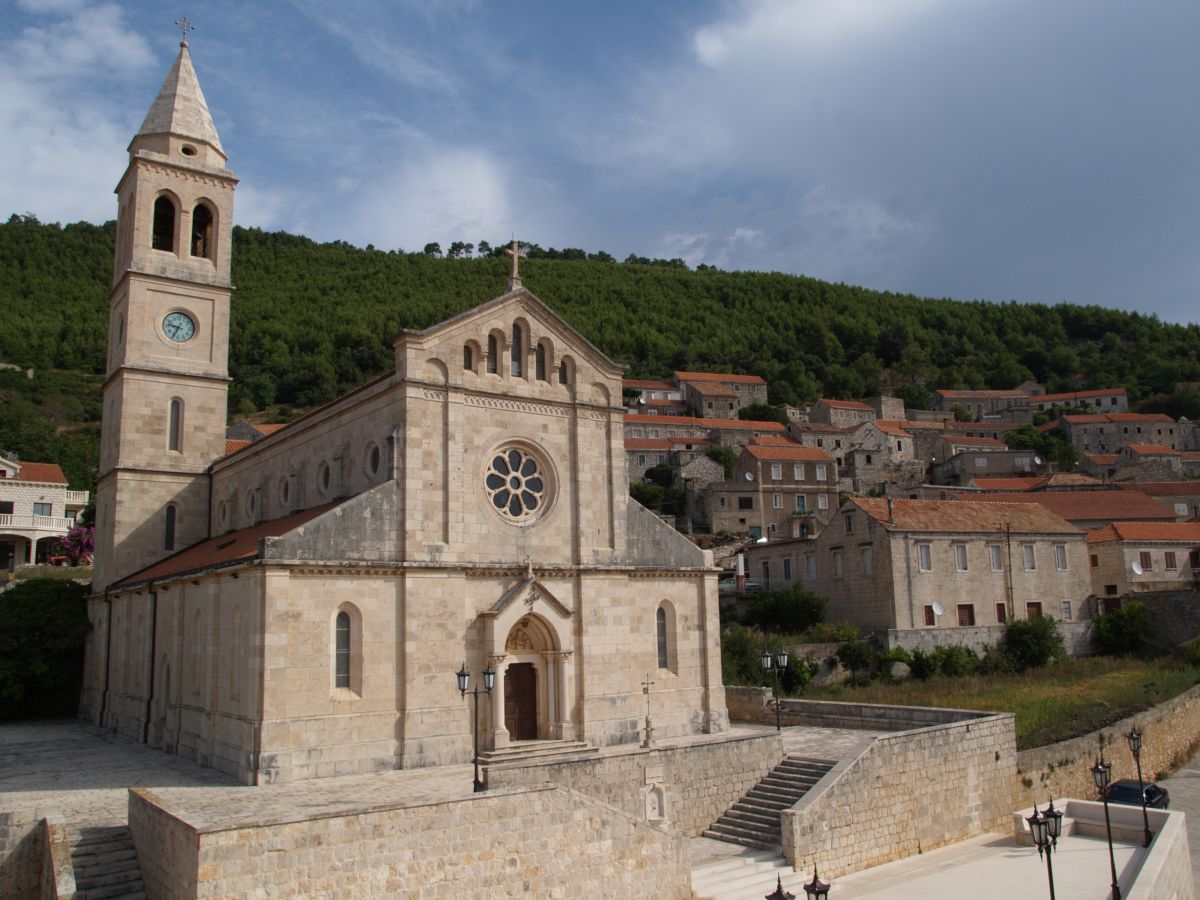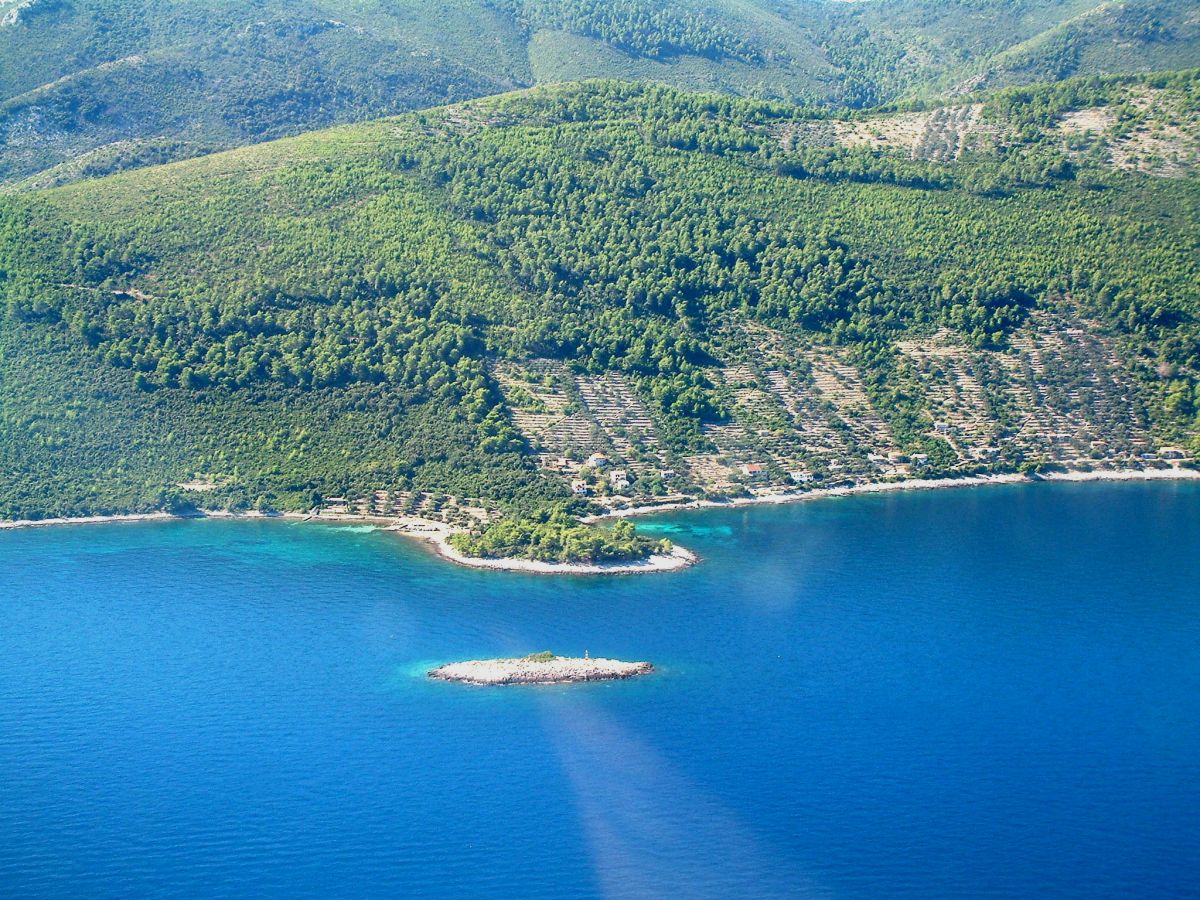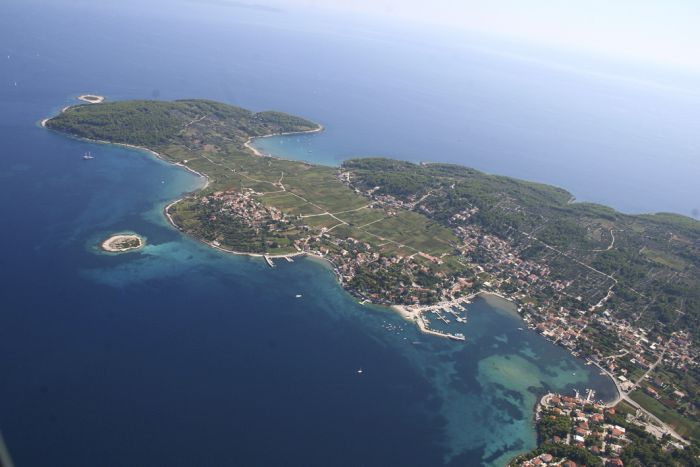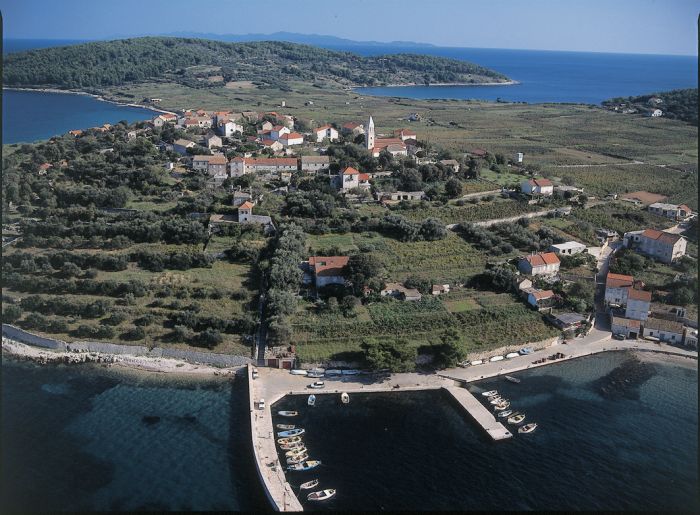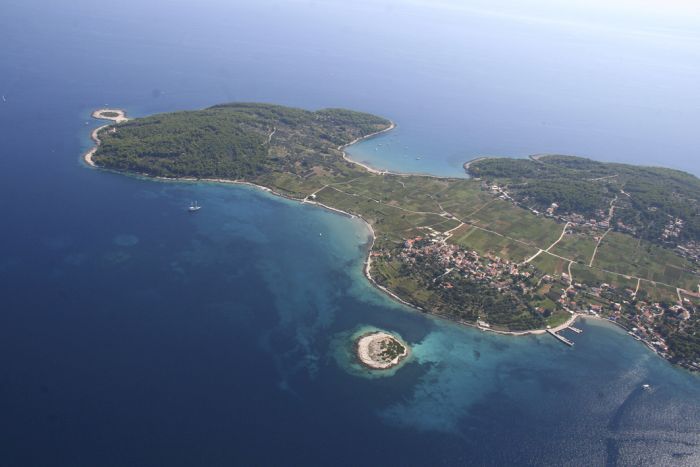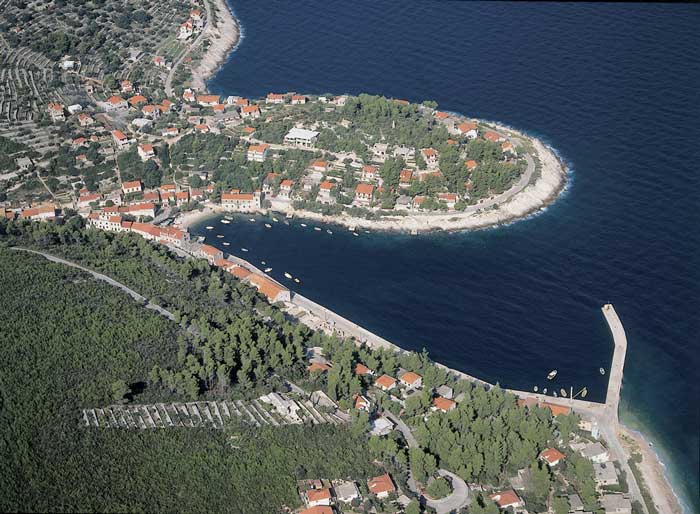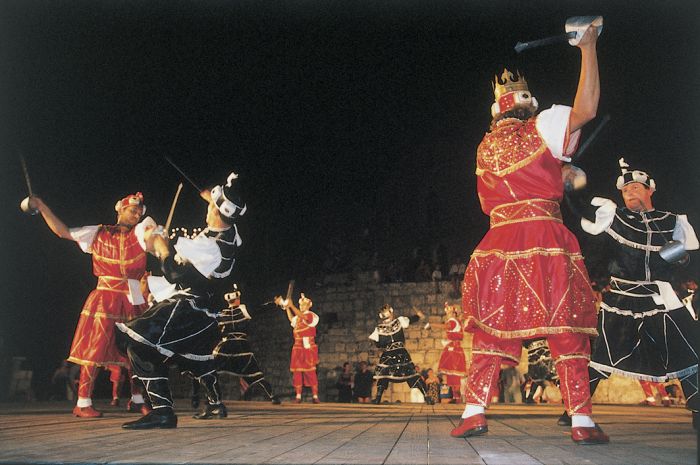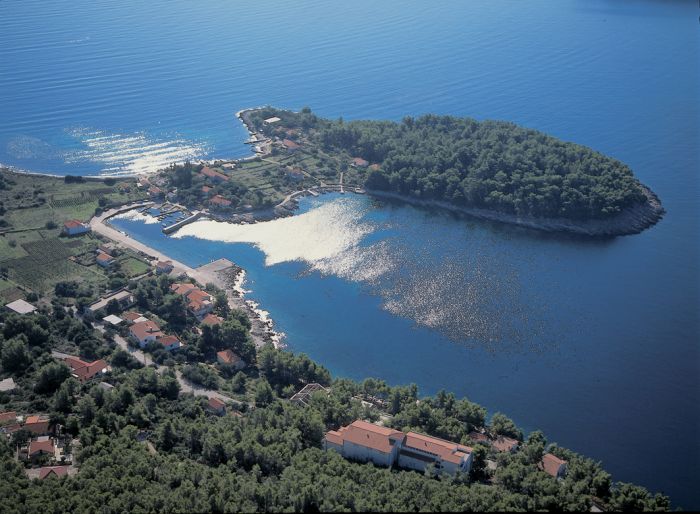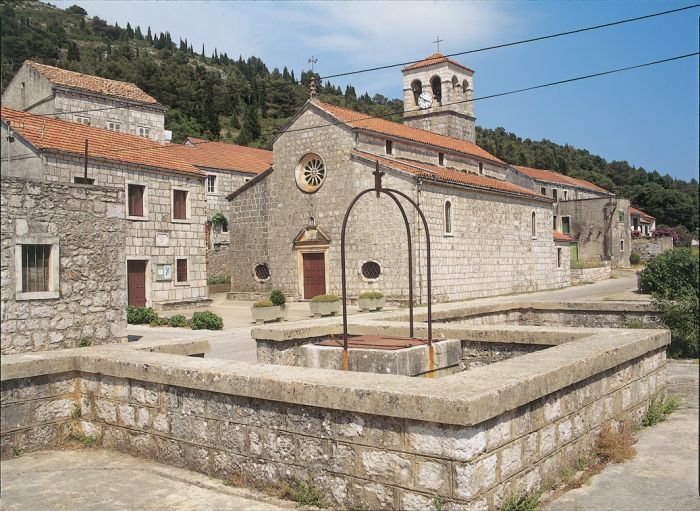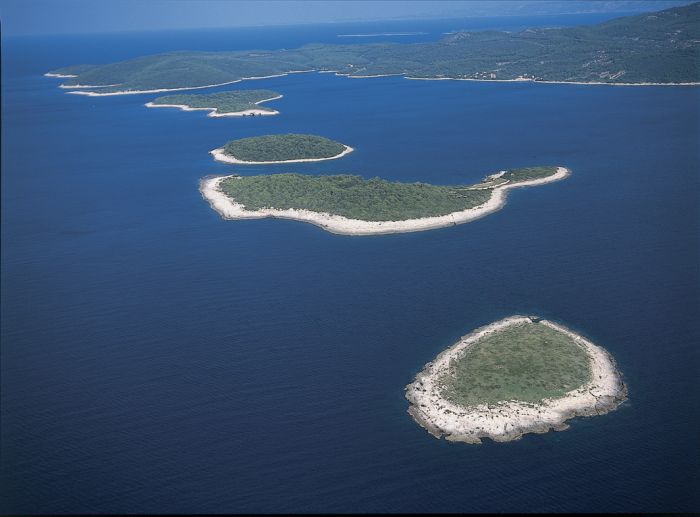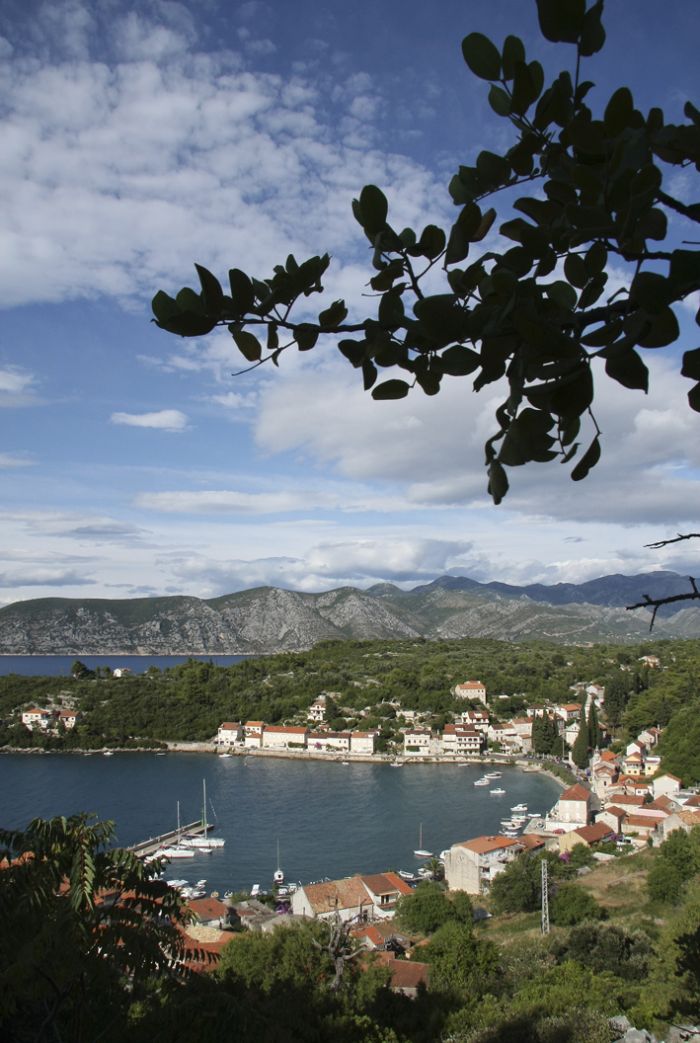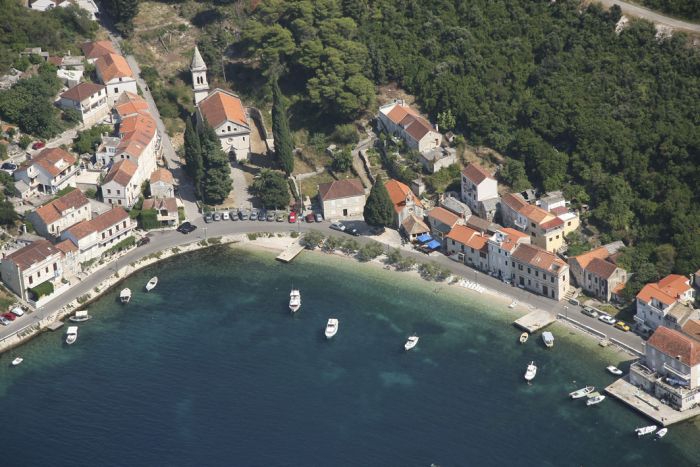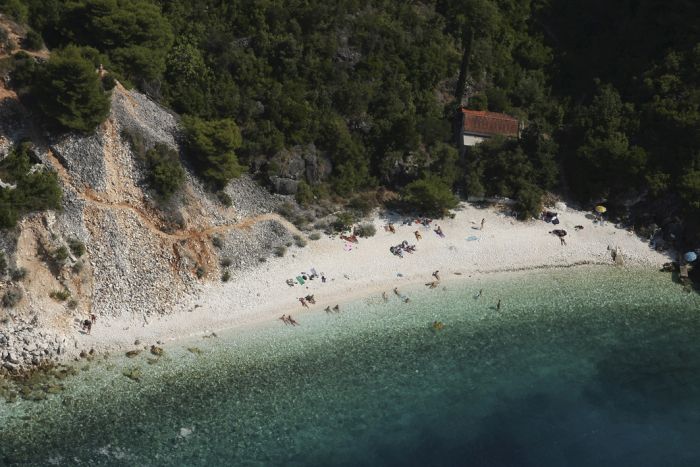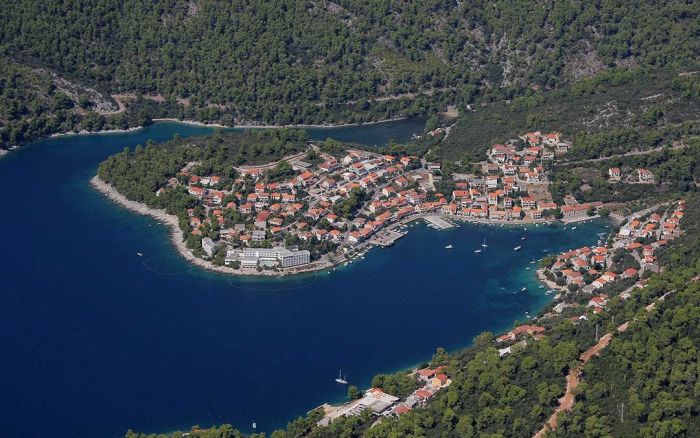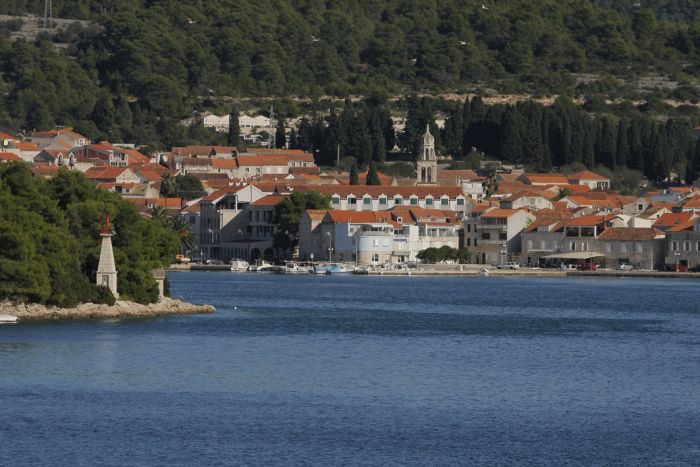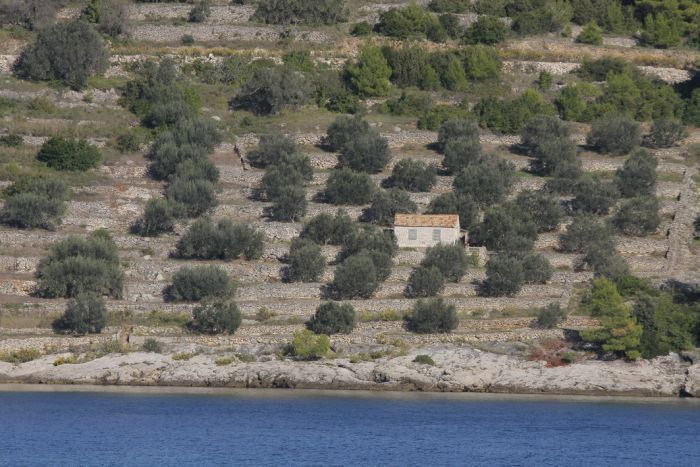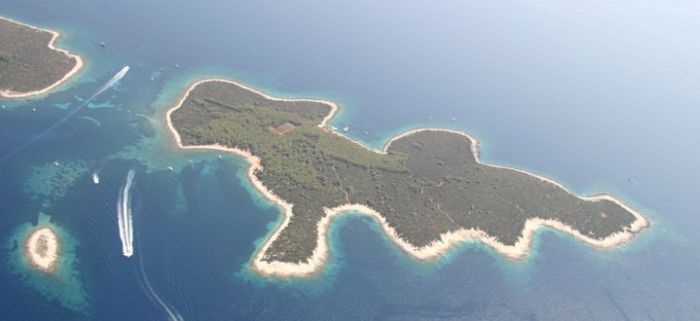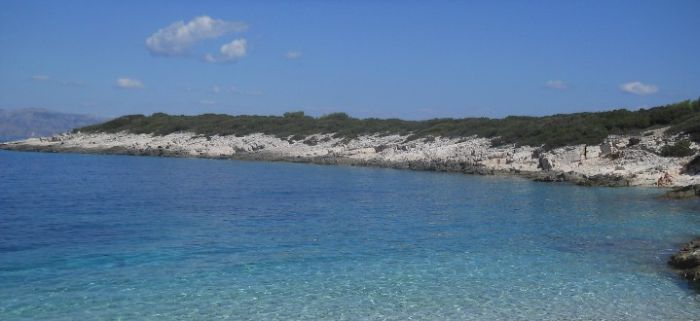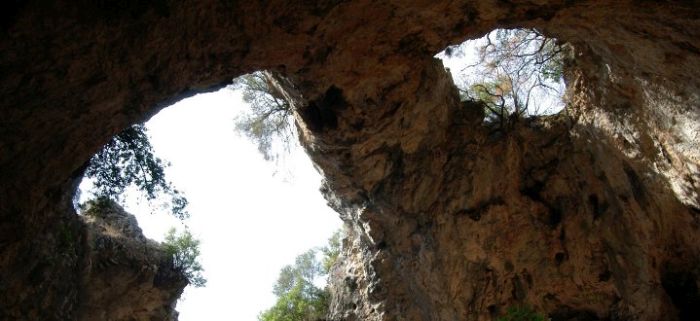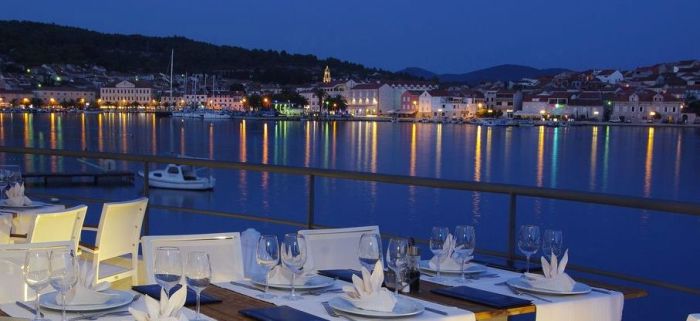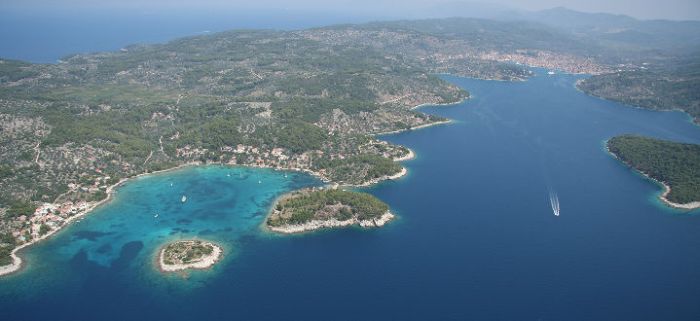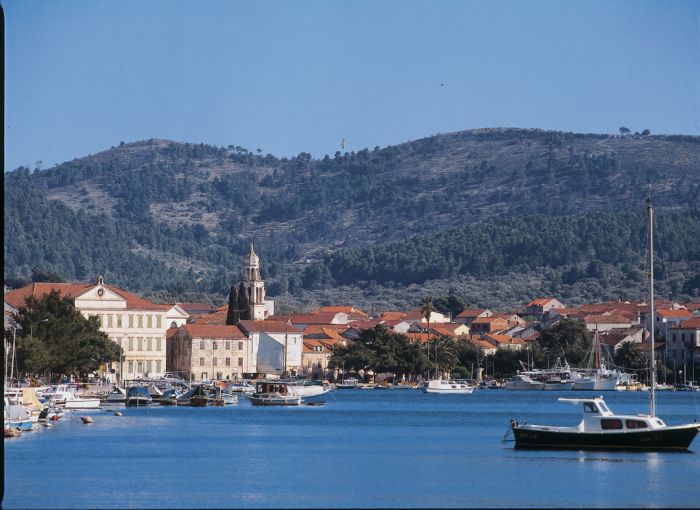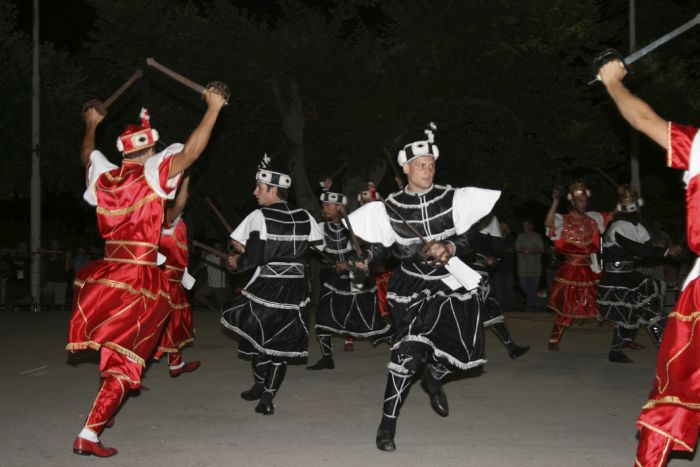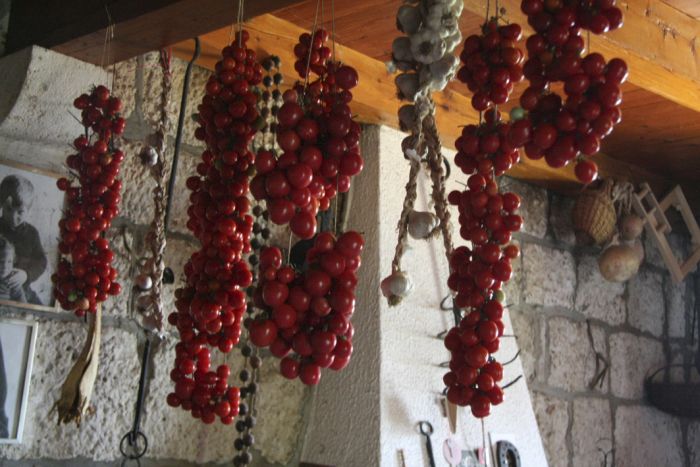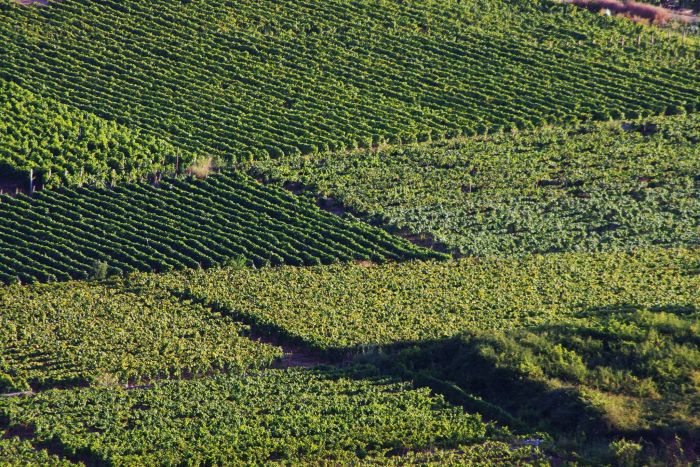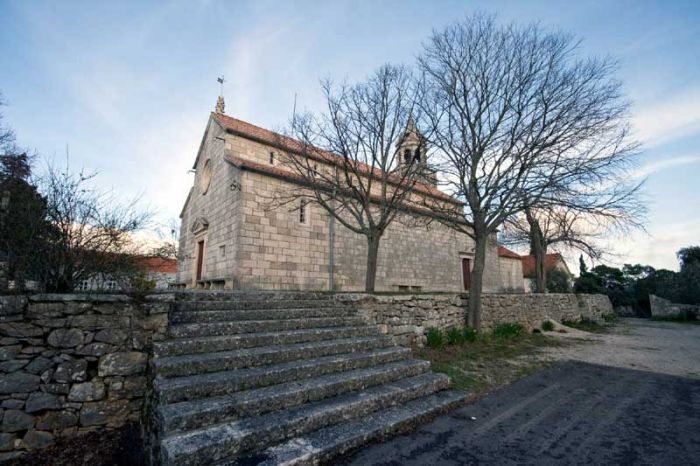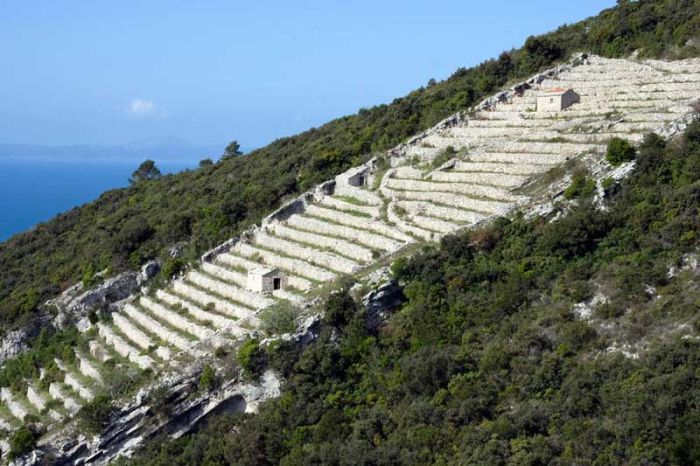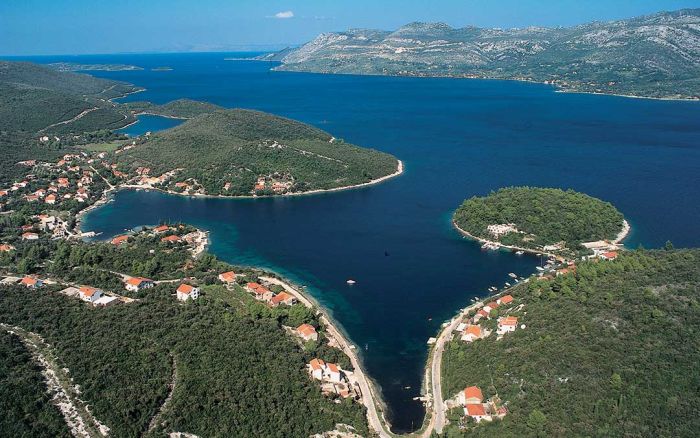Korčula
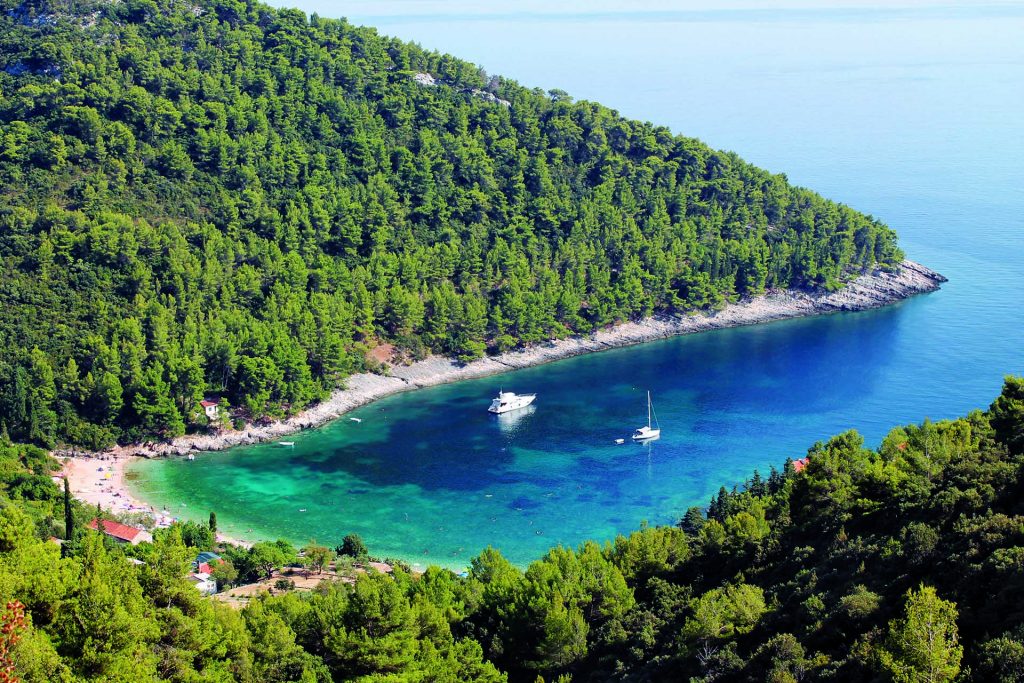 L’île de Korčula est habitée depuis la préhistoire et des traces de vie ancienne ont été trouvées dans de nombreux endroits. Les découvertes les plus anciennes sont les couteaux en pierre datant du néolithique trouvés sur la petite île de Badija en face de la ville de Korcula. La grotte Vela špilja qui se trouve à Vela Luka est le site néolithique le plus riche et le mieuxexploré.
L’île de Korčula est habitée depuis la préhistoire et des traces de vie ancienne ont été trouvées dans de nombreux endroits. Les découvertes les plus anciennes sont les couteaux en pierre datant du néolithique trouvés sur la petite île de Badija en face de la ville de Korcula. La grotte Vela špilja qui se trouve à Vela Luka est le site néolithique le plus riche et le mieuxexploré.
Au 6e siècle av. JC les Grecs se sont installés sur l’île, tout d’abord aux alentours de Vela Luka et ont dénommé l’île Corcyra Melaina, en français Corcyre noire. Un peu plus tard arrivent les Grecs de l’île de Vis (Isse) à l’autre extrémité de l’île dans la région de l’actuelle Lumbarda où ils fondent une importante colonie dont témoigne l’inscription PSEFIZMA datant du 3e siècle av. JC, découverte à la fin du 19e siècle.
Au premier siècle après JC l’île et la Dalmatie entière sont conquises par les Romains qui ont dénommé l’île Corcyra Nigra. Au septième siècle les Slaves-Croates arrivent jusqu’aux rivages de l’Adriatique pour y fonder leur propre état. Ce sera tout d’abord une province gérée par des princes qui deviendra un royaume à partir de l’année 925, date du couronnement du premier roi Tomislav. L’île de Korčula appartient alors à cet état. En fuyant l’invasion des Slaves, la population romaine est venue dans les îles de Brač, Hvar et Korčula. La plupart d’entre eux s’est retourné dans leur pays d’origine après la fin des conquêtes slaves. Les autres se sont assimilés aux nouveaux arrivants.
En l’an 1000, le chef de la République de Venise Pierre II Orseolo conquit la plupart des villes et des îles dalmates, et l’île de Korcula passe ainsi sous la domination de Venise. À partir de ce moment-là, Korčula va souvent changer de gouvernants. Venise est destituée par les princes de Zahumlje, puis viennent les rois croato-hongrois, ensuite Venise, et entre 1413-1420 la République de Dubrovnik. Venise domine encore une fois entre 1420-1792. Quand Napoléon fit tomber la République de Venise, l’Autriche prend possession de la Dalmatie, pour un très court laps de temps, car les Français arrivent bien vite.
Entre 1804 et 1805, Korčula a changé de possession entre Français et Russes. Les Français gouvernent entre 1807 et 1813 puis les Anglais jusqu’à 1815, quand le congrès de Vienne dessinée de nouvelles frontières européennes. La Dalmatie passe sous l’administration autrichienne et y reste jusqu’à la fin de la première guerre mondiale (1918). Ce n’est qu’en 1921 qu’elle s’incorpore dans le nouvel État des Slovènes, des Croates et des Serbes qui prend plus tard le nom de Royaume de Yougoslavie. Après les élections démocratiques de 1990, par referendum, le peuple croate déclare son indépendance vis-à-vis de la Yougoslavie et la République de Croatie est déclarée état indépendant.
La ville de Korčula
La ville de Korčula est située dans la partie orientale de l’île éponyme.
Comme l’ensemble de l’île, la ville de Korčula est également riche en beauté naturelle, forêts, baies, îlots, collines grâce à son climat tempéré.
La vieille ville médiévale de Korčula est un véritable musée en plein air qui attire les visiteurs avec son architecture harmonieuse. Grâce à la vieille tradition de taillage de la pierre, la vieille ville est construite et luxueusement décorée par des artisans locaux au 14e, 15e et 16e siècle en style gothique fleuri, renaissance et baroque. Les attractions touristiques sont : le tracé des rues, les places, les murailles, les tours, les églises, les palais, les édifices publics et privés, les musées, les collections des musées, le musée d’icônes et la maison du grand explorateur Marko Polo en ruines avec la tour.
Le bijou de l’architecture est certainement la Cathédrale Saint-Marc dont le campanile fut construit par Marko Andrijić, un des artisans les plus connus de l’île dans la seconde moitié du 15e siècle.
Le statut de la ville et de île de Korčula datant de 1214 confirme que la ville existait déjà à cette époque.
La Moreška est un jeu chevaleresque qui est conservé dans cette ville depuis plus de 400 ans. Grâce aux Moreška, Kumpanija et Moštra, l’île de Korčula est la seule île de la Méditerranée avec une riche tradition chevaleresque – les danses des épées. La Moreška est présenté régulièrement pendant la saison estivale. Le centre culturel de Korčula prépare aussi un programme culturel riche.
Marco Polo a commencé son voyage en Extrême-Orient, la Route de la soie, depuis son village natal avec lequel il a été très lié. Cela ne semble pas être qu’une légende, ce que confirme la bataille navale entre Gênes et Venise le 7 septembre 1298 qui s’est déroulée aux portes de la ville de Korčula (100 bateaux et 15 000 participants) et dans laquelle Marco Polo a été capturé et emprisonné à la prison de Gênes en tant que commandant d’un galion vénitien. Il a profité de sa détention pour dicter à son compagnon de cellule Rustichelli ses mémoires : Le Livre des Merveilles du monde.
La tour de la maison de Marco Polo, près de la cathédrale, est ouverte au public, ainsi que l’exposition du Musée de Marco Polo à l’extérieur des murs de la ville, illustrant la vie du plus célèbre voyageur et explorateur du monde.
La ville de Korčula peut offrir à ses visiteurs de nombreuses manifestations culturelles, traditionnelles, sportives et de divertissements ainsi que les hébergements de qualité; hébergement privé, hôtels, campings. L’offre touristique à l’ACI Marina Korčula jouit d’une réputation enviable.
Information
Korčula Tourist Board
Trg 19.travnja 1921., 40
20260 Korčula
info@visitkorcula.eu
www.visitkorcula.eu
Tel: +385 (0) 20 715701
Badija
Un îlot (d’une surface d’environ 1 km2) situé dans la partie est du canal de Peljesac. Le canal Jezevica le sépare de l’île de Korcula. La température annuelle moyenne est de 13°C. L’îlot possède, sur sa côte sud, un bon amarrage pour les bateaux moyens, et à l’est du couvent, un bon mouillage pour les petits bateaux.
L’îlot de Badija tout entier est couvert de maquis et de forêts de pins. Son plus haut sommet atteint 74 m d’altitude. Le couvent d’aujourd’hui et l’église attenante, de style gothique tardif, sont construits après 1420. Le couvent est élargi en 1909, et transformé en une résidence de sport et de loisir en 1950. Sur la colline au-dessus du couvent, on voit la petite église Sainte-Catherine construite aux XVe et XVIe siècles.
Information
Korčula Tourist Board
Trg 19. travnja 1921., 40
20260 Korčula
info@visitkorcula.eu
www.visitkorcula.eu
Tel: +385 (0) 20 715701
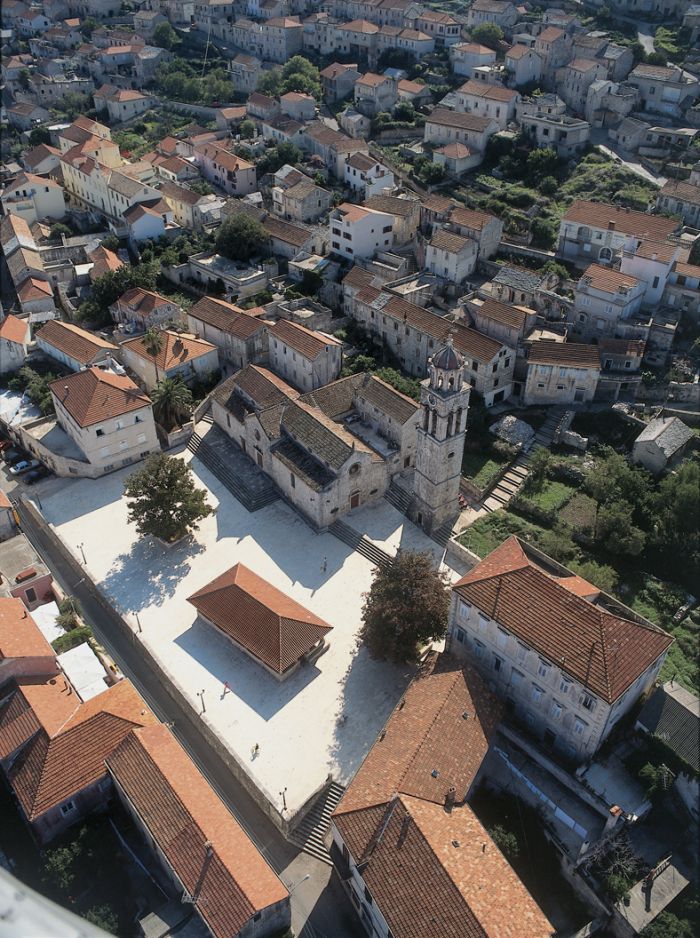 Blato
Blato
La commune de Blato compte environ 4000 habitants. On y arrive par la grande route qui traverse la zone forestière de la partie centrale de l’île de Korcula, via Smokvica. Le village, en forme d’amphithéâtre, est dispersé sur plusieurs collines au milieu desquelles est située une petite plaine.
Plusieurs bâtiments publics ont été récemment construits le long de sa grande allée de tilleuls appelée « Zlinja »: écoles, hôtel, banques, commerces, Hôtel de ville et polyclinique. La vieille place pavée de la cité historique, au sud de l’allée de Zlinja, est dominée par l’église-halle de la Toussaint. Celle-ci est mentionnée au haut Moyen Âge, mais comme elle était élargie à plusieurs reprises, sa silhouette actuelle et son clocher baroques datent des XVIIe et XVIIIe siècles. L’autel majeur est orné du tableau « La Toussaint » (1540), l’œuvre du maître vénitien Girolamo Da Santa Croce. La nef du sud est élargie au XVIIIe siècle par la chapelle de la Sainte-Vincenza, dont l’autel en marbre avec des riches ornements enferme la relique sacrée de cette martyre dans un reliquaire en argent.
La fête célébrée en l’honneur de cette sainte, le 28 avril, est aussi le jour de fête de la municipalité de Blato. Une grande procession fait le tour du village, et les festivités dites « Kumpanija » se déroulent sur la place devant l’église. Le petit musée à côté de l’église possède une collection remarquable d’oeuvres d’art, d’objets précieux, de documents et d’objets découverts au cours des fouilles archéologiques, qui témoignent de l’histoire de la municipalité de Blato. La loge baroque, construite en 1700, se trouve devant l’église, sur la vieille place.
La commune de Blato possède un grand nombre de petites églises et de chapelles. Les églises et les chapelles les plus anciennes sont celles des Saints-Côme-et-Damien du VIe siècle, Sainte-Marie-aux-Champs, Saint-Martin etc. La résidence d’été baroque « Arneri » dans la partie centrale de la municipalité représente l’un des plus beaux châteaux ayant appartenu à l’aristocratie de Korcula. Il abrite aujourd’hui le musée de la ville, dans lequel sont exposées plusieurs collections du patrimoine archéologique, historique et ethnologique de la région. A l’heure actuelle, les habitants de Blato se tournent de plus en plus vers le tourisme, l’industrie et le commerce. Parmi les unités de production industrielle, il faut mentionner celles de Radez et de Triklop.
L’association des chevaliers « Kumpanija » participe de manière active à la promotion du patrimoine culturel du pays, de la danse d’escrimeurs et des autres danses et chants folkloriques.
L’association culturelle et artistique « Petar Milat » réunit également les amateurs de la musique traditionnelle, ainsi que les groupes vocaux, dits « klape », qui chantent a capela les mélodies dalmates. La route asphaltée qui mène vers la côte nord traverse les deux cimetières (vieux et nouveau) et arrive au port de Prigradica, qui dispose de plages agréables et de plusieurs résidences d’été et petites pensions de famille au bord de la mer. Plusieurs artistes, peintres, musiciens et scientifiques croates éminents sont originaires de la municipalité de Blato. L’élue de Dieu Marie du Jésus Crucifié Petkovic, née en 1892 à Blato, a été béatifiée le 6 juin 2003 à Dubrovnik par sa Sainteté le Pape Jean-Paul II.
Information
Blato Tourist Board
Trg dr. F. Tuđmana 4
20271 Blato
tzo-blato@du.t-com.hr
www.tzo-blato.hr
Tel: +385 (0) 20 851850
Fax: +385 (0) 20 851241
Brna
Un petit port et une baie de la côte sud de l’île de Korcula, à 4 km dans le sud-ouest du village de Smokvica. C’est le port du village de Smokvica. La baie est séparée en deux par la presqu’île minuscule de Mali Zaglav; le village et le port de Brna sont situés dans la partie est de la baie.
Une côte rocheuse et abrupte relie les villages de Prizba, à l’ouest, et de Zavalatica, à l’est. Leurs plages de sable sont entourées de maquis et de forêts de pins. Les îlots de Vrhovnjak, Crklica, Stupa, Otocac et Sridnjak se trouvent en face de la côte reliant les village de Brna, à l’est, et de Prizba, à l’ouest.
Au XIXe s. le village de Brna servait de port d’exportation du vin produit dans le village de Smokvica vers d’autres ports adriatiques et méditerranéens. Aujourd’hui, ses habitants s’orientent de plus en plus vers le tourisme. A part un hébergement confortable, l’offre touristique inclut une offre gastronomique: les visiteurs peuvent déguster les spécialités de poissons et d’excellents vins blancs, tels « posip » et « rukatac », produits dans le village de Smokvica. La baie d’Istruga, à proximité du village de Brna, possède les boues thermales très appréciées par la population locale, bien qu’il n’existe toujours pas de thérapies organisées.
Information
Smokvica Tourist Board
Brna bb, 20272 Smokvica
tzo-smokvica@du.t-com.hr
www.brna.hr
Tel: +385 (0) 20 832255
Fax: +385 (0) 20 832188
Lumbarda
La commune de Lumbarda, qui compte 1224 habitants, est située à 6 km (à l’est) de Korcula. En font partie les petites baies et les plages de sable sur la côte, ainsi que les collines entourées des champs de vignes. Une colonie grecque y était fondée au IIIe s. av. J.-C., dont témoigne l’inscription Psefizma, le plus vieux document écrit en Croatie.
Une résidence de campagne romaine, villa rustica, était située dans le vallon, à proximité du bord de mer (au lieu-dit Bilino zalo). A partir du XVIe siècle, les habitants riches de Korcula, propriétaires de terrains, font construire à Lumbarda, aux endroits les plus attrayants, des châteaux, dont certains sont aujourd’hui bien conservés et habités, tels les châteaux Nobilo, Milina et Krsinic.
Sur la colline, dans la partie la plus ancienne du village de Vela glavica, on voit l’église paroissiale à trois nefs Saint-Roch, patron de Lumbarda. Le village possède plusieurs petites chapelles: Saint-Bartolomé, Saints-Pierre-et-Paul, Sainte-Barbara, La Nativité de la Vierge. Entourée de vignes, la petite église Sainte-Croix, construite en 1774, se distingue par son portique caractéristique.
La commune de Lumbarda est située sur sept collines. Le petit village de Javic, à l’ouest de Lumbarda, est entouré de plantations d’oliviers, d’amandiers et de figuiers. On a fait construire dans ce petit village l’église Saint-Esprit.
Selon la légende, le vin « grec » y est offert à l’Ulysse par la déesse Kirke.
Une randonnée pédestre est prévue à travers la commune de Lumbarda tout entière, jusqu’au phare Raznjic, à l’extrémité est de l’île, près de la baie Przina (Sable), où la mer est toujours plus chaude que dans les autres baies.
Information
Lumbarda Tourist Board
Prvi žal bb, 20263 Lumbarda
info@visitlumbarda.eu
www.visitlumbarda.eu
Tel/Fax +385 (0) 20 712005
Prigradica
Le village de Prigradica est situé sur la côte nord de l’île de Korcula, à proximité du village de Blato. Prigradica était autrefois un port d’exportation du vin et de l’huile d’olives de haute qualité, produits à Blato. Aujourd’hui, c’est un site touristique qui garde son caractère rustique authentique. Les villages avoisinants, intacts depuis des siècles, donnent au visiteur l’impression unique de se retrouver dans une époque passée.
Information
Blato Tourist Board
Trg dr. F. Tuđmana 4
20271 Blato
tzo-blato@du.t-com.hr
www.tzo-blato.hr
Tel: +385 (0) 20 851850
Fax: +385 (0) 20 851241
Prižba
Une baie splendide du côté sud de l’île de Korcula, l’une des plus belles de l’île. Elle est entourée de champs de vignes fertiles, de villas luxueuses, de forêts de conifères et de pierres rocheuses.
Information
Blato Tourist Board
Trg dr. F. Tuđmana 4
20271 Blato
tzo-blato@du.t-com.hr
www.tzo-blato.hr
Tel: +385 (0) 20 851850
Fax: +385 (0) 20 851241
Pupnat
Le village de Pupnat (environ 600 habitants) est situé à 13 km de la ville de Korcula. A la sortie du village de Zrnova, la route sinueuse monte jusqu’au village de Pupnat qui s’est installé dans le pli du vallon. Ses habitants vivent, pour la plupart, de l’agriculture et de l’élevage, mais s’orientent petit à petit vers d’autres métiers, tels la construction, le tourisme etc. L’église de Notre-Dame-de-Neige, reconstruite plusieurs fois, se trouve dans la partie centrale du village. L’église voisine Saint-George, construite au XVe siècle, est entourée d’un petit cimetière et de quelques vieilles chapelles délabrées.
La nouvelle route continue à monter, jusqu’au sommet de la colline, d’où s’étend une belle vue sur la côte sud de l’île et le port Pupnatska luka entouré de forêts de pins, et sur les îles lointaines de Lastovo et de Mljet. Si l’on emprunte la vieille route, qui traverse les collines de la côte sud, on a une vue panoramique splendide. Les amateurs de la randonnée pédestre peuvent descendre dans le port de Pupnat.
Information
Korčula Tourist Board
Trg 19. travnja 1921., 40
20260 Korčula
info@visitkorcula.eu
www.visitkorcula.eu
Tel: +385 (0) 20 715701
Račišće
En quittant la ville de Korcula vers l’ouest, on traverse d’abord plusieurs baies, Medvidnjak, Banja, Vrbovica et Kneza, avec leurs plages, campings et villas. Le petit village de Kneza, qui était autrefois un village de pêcheurs, abrite les vestiges d’une mosaïque romaine, et le village de Banja les ruines d’édifices romains.
Au bout de 12 km de route, on arrive au village de Racisce (environ 600 habitants), fondé au XVIIe siècle par les réfugiés d’Herzégovine et de Makarska, qui ont fui devant les Turcs. Dans le passé, sa population vivait de la pêche, de l’élevage, de l’agriculture et de la navigation. Aujourd’hui, ses habitants sont, pour la plupart, des navigateurs.
L’église Notre-Dame, avec une petite loge devant l’entrée, est construite en 1682. L’église Saint-Nicolas, qui est l’église paroissiale actuelle, date de la fin du XIXe siècle.
Information
Korčula Tourist Board
Trg 19. travnja 1921., 40
20260 Korčula
info@visitkorcula.eu
www.visitkorcula.eu
Tel: +385 (0) 20 715701
Smokvica
Ce petit village qui compte quelque 1000 habitants est situé sur la grande route, à 29 km de la ville de Korcula. Il est construit sur la pente sud de la colline qui domine les vastes plantations de vignes, où l’on cultive la variété de raisin appelée « posip ». Le village possède également une entreprise moderne de production et de mise en bouteilles du vin de haute qualité qui porte le même nom. La grande église néo romane Notre-Dame est construite en 1920 à l’emplacement de l’ancienne église, suivant le devis d’O. Ivekovic. Une loge baroque entourée de colonnes est attenante à l’église. Les chateaux-forts du village étaient autrefois des résidences d’été de riches aristocrates.
On peut y voir quelques petites églises très simples, du haut Moyen Âge. L’association culturelle et artistique « Ante Cefer » promeut la musique et le folklore local (danse d’escrimeurs) dit « Kumpanija ». Une route latérale mène vers le sud, jusqu’aux deux baies entourées de forêts de pins. La baie Brna possède un hôtel, plusieurs pensions de familles et villas, tandis que la baie Istruga est connue par ses boues thermales utilisées dans la thérapeutique rhumatologique.
Le prolongement de la route qui relie la côte sud et la côte ouest mène au site touristique de Priscapac, disposant de plusieurs maisons et chambres d’hôtes et de belles plages, puis aux baies de Prizba et Grscica, avec des hôtels entourés de forêts de pins et plusieurs pensions et maisons familiales. La route monte vers le nord et vers l’intérieur de l’île, jusqu’à la municipalité de Blato.
Information
Smokvica Tourist Board
Brna bb, 20272 Smokvica
tzo-smokvica@du.t-com.hr
www.brna.hr
Tel: +385 (0) 20 832255
Fax: +385 (0) 20 832188
Vela Luka
Vela Luka est la plus grande ville de l’île de Korcula. Cette commune qui compte quelque 5000 habitants se trouve à 42 km de la ville de Korcula, avec laquelle elle est reliée par la grande route. La commune s’est développée vers la fin du XIXe siècle dans un golfe spacieux et bien protégé. Elle dispose des bâtiments de logement et de la clinique de thérapeutique rhumatologique « Kalos ». Ses habitants vivent de l’agriculture, de la pêche, du tourisme, ou bien, sont employés dans le chantier naval Greben, dans l’usine des produits de poissons Jadranka et dans d’autres entreprises industrielles et commerciales plus petites. Le centre culturel situé dans l’ancienne résidence d’été « Kastel », bâtiment baroque récemment reconstruit, possède une collection archéologique remarquable du site néolithique voisin de Vela spilja et des localités romaines environnantes. Y est exposée également une collection d’oeuvres d’art modernes: tableaux, dessins et sculptures d’artistes croates et étrangers de renom, offerte à la municipalité de Vela luka dans les années 70. La galerie d’art de Mme Anka Prizmic Sego, inaugurée en 1983, expose de nombreuses sculptures et tableaux de cette artiste née à Vela Luka.
L’église paroissiale Saint-Joseph est un édifice classiciste construit en 1848. Les stations du Chemin de la Croix, 15 petits reliefs, sont l’oeuvre d’Anka Prizmic. La chapelle de Saint-Vincent, construite en 1589, a été reconstruite à plusieurs reprises. Le buste de Don Iva Oreba, prêtre qui a beaucoup contribué au développement culturel de cette ville au XXe siècle, est également l’oeuvre d’Anka Prizmic. La petite chapelle est surmontée de la statue en bronze « Pieta » du même auteur.
L’association culturelle et artistique « Hum » promeut la musique et le folklore, ainsi que le chant choral. Parmi les groupes vocaux dits « klape », il faut mentionner ceux d’Osjak et de Greben, dont les concerts et la performance artistique ont connu un grand succès en Croatie et à l’étranger. De nombreuses baies aux environs de Vela Luka attirent les baigneurs. L’îlot d’Osjak a un charme particulier.
Information
Vela Luka Tourist Board
Obala 3 br.19
20270 Vela Luka
tzo-vela-luka@du.t-com.hr
www.tzvelaluka.hr
Tel/Fax: +385 (0) 20 813619
Čara
Ce village traditionnel typique qui compte quelque 700 habitants, est situé sur la grande route, à 25 km de la ville de Korcula. Le village de Cara est construit sur la pente sud de la colline qui domine des champs fertiles plantés de vignes. On y cultive une variété de raisin spéciale appelée « posip ». Le village possède également une cave viticole de fabrication du vin de haute qualité qui porte le même nom. L’église paroissiale Saint-Pierre, dans la partie centrale du village, est construite au XVe siècle et reconstruite à plusieurs reprises. Son clocher est reconstruit dans les années 80 du siècle passé.
Un cyprès séculaire domine la place pavée en face de l’église. Le maître-autel de l’église est orné d’un tableau représentant l’Ascension de Christ, l’oeuvre du célèbre peintre vénitien de la Renaissance, Jacopo Bassano (la fin du XVIe s.). De même que les autres villages de l’île, le village de Cara possède, dans la baie voisine de Zavalatica, plusieurs résidences d’été ayant appartenues à des aristocrates et propriétaires riches de l’île de Korcula. Les vieux et nouveau cimetières, avec l’église votive Notre-Dame-de-Carsko-polje construite au XIVe siècle et reconstruite dans un style baroque, se trouvent dans l’un des champs, au milieu des vignes.
L’autel est orné de reliefs encadrés représentant les scènes de la vie de la Vierge Marie. On dit que ces reliefs du gothique tardif en albâtre d’origine anglaise, fabriqués dans l’atelier de Nottingham au XVe siècle, ont été charriés dans la baie voisine de Cavici par la mer, et il existe même une légende sur leur arrivée miraculeuse dans le village de Cara. Cette église est le pèlerinage le plus fréquenté de l’île de Korcula: la Saint Jacques le Majeur, le 25 juillet, est une grande fête: la population de l’île entière participe à la procession votive qui fait le tour du champ Carsko polje avec, à la tête, le relief représentant le visage de la Vierge Marie. L’association culturelle et artistique « Les frères Krnomiri », qui est fondée dans le village de Cara, porte le nom des frères légendaires qui ont lutté contre le doge et l’aristocratie vénitienne pour les droits des paysans corvéables.
La baie de Zavalatica voisine (à 2 km, dans le sud, une route asphaltée) possède de nombreuses résidences de tourisme modernes et confortables, construites tout près de la mer.
Information
Korčula Tourist Board
Trg 19. travnja 1921., 40
20260 Korčula
info@visitkorcula.eu
www.visitkorcula.eu
Tel: +385 (0) 20 715701
Žrnovo
Le village de Zrnovo compte aujourd’hui plus de 1000 habitants. On en fait mention dans les documents écrits datant du haut Moyen Âge. Une large route asphaltée relie le village de Zrnovo avec la ville de Korcula (à 4 km). Cette route traverse la partie centrale du village, dont les hameaux – Prvo Selo, Kampus, Postrana et Brdo – sont dispersés sur les collines voisines. Les vieilles maisons en pierre avec portiques et terrasses pavées sont accompagnées de petites étables, avec murs en pierres sèches et couvertures en plaques de pierre. On y voit quelques châteaux, anciennes résidences d’été d’aristocrates et de grands propriétaires de Korcula, et plus loin, sur une colline rocheuse, au milieu des pins, l’église paroissiale Saint-Martin du XIVe, reconstruite récemment. L’église Saint-Roch, dans le petit village de Postrana, est située sur une petite place pavée, bordée d’arbres séculaires dits « kostili », où se déroule la fête traditionnelle de la danse d’escrimeurs ou moresque. L’église Saint-Germain (Sveti Vid) du XIIIe s. avec cimetière est plus éloignée.
Le village possède plusieurs petites chapelles anciennes. Le château Banicevic, dans le village de Postrana, qui appartenait à cette famille aristocratique éminente, est bien conservé. Sur la façade, on voit la plaque avec les armoiries et l’inscription concernant le membre le plus connu de cette famille, Jakov Banicevic (XVIe s.), grand humaniste européen.
Les habitants du village de Zrnovo vivaient de l’agriculture (viticulture, oléiculture, horticulture) et de la taille des pierres. Aujourd’hui, de nombreux îliens sont employés dans des entreprises de construction et dans le tourisme. Les baies voisines (de la côte nord), Banja, Medvidnjak et Vrbovica, possèdent plusieurs pensions de famille modernes et bien équipées et des campings tout près de la mer. L’association culturelle et artistique « Chasubles » réunit les amateurs de l’art théâtral et du folklore, et l’association « Union fraternelle » promeut la tradition et le folklore local. Plusieurs artistes croates reconnus sont originaires de Zrnovo (Radoslav Duhovic, sculpteur , Nikola Skokandic, art graphique, Ante Radovanovic, Frano Cebalo, Abel Brcic, peintres), ainsi que le célèbre écrivain et académicien croate, Petar Segedin.
Information
Korčula Tourist Board
Trg 19. travnja 1921., 40
20260 Korčula
info@visitkorcula.eu
www.visitkorcula.eu
Tel: +385 (0) 20 715701
- La ville de Korčula
-
La ville de Korčula
La ville de Korčula est située dans la partie orientale de l’île éponyme.
Comme l’ensemble de l’île, la ville de Korčula est également riche en beauté naturelle, forêts, baies, îlots, collines grâce à son climat tempéré.
La vieille ville médiévale de Korčula est un véritable musée en plein air qui attire les visiteurs avec son architecture harmonieuse. Grâce à la vieille tradition de taillage de la pierre, la vieille ville est construite et luxueusement décorée par des artisans locaux au 14e, 15e et 16e siècle en style gothique fleuri, renaissance et baroque. Les attractions touristiques sont : le tracé des rues, les places, les murailles, les tours, les églises, les palais, les édifices publics et privés, les musées, les collections des musées, le musée d’icônes et la maison du grand explorateur Marko Polo en ruines avec la tour.
Le bijou de l’architecture est certainement la Cathédrale Saint-Marc dont le campanile fut construit par Marko Andrijić, un des artisans les plus connus de l’île dans la seconde moitié du 15e siècle.
Le statut de la ville et de île de Korčula datant de 1214 confirme que la ville existait déjà à cette époque.
La Moreška est un jeu chevaleresque qui est conservé dans cette ville depuis plus de 400 ans. Grâce aux Moreška, Kumpanija et Moštra, l’île de Korčula est la seule île de la Méditerranée avec une riche tradition chevaleresque – les danses des épées. La Moreška est présenté régulièrement pendant la saison estivale. Le centre culturel de Korčula prépare aussi un programme culturel riche.
Marco Polo a commencé son voyage en Extrême-Orient, la Route de la soie, depuis son village natal avec lequel il a été très lié. Cela ne semble pas être qu’une légende, ce que confirme la bataille navale entre Gênes et Venise le 7 septembre 1298 qui s’est déroulée aux portes de la ville de Korčula (100 bateaux et 15 000 participants) et dans laquelle Marco Polo a été capturé et emprisonné à la prison de Gênes en tant que commandant d’un galion vénitien. Il a profité de sa détention pour dicter à son compagnon de cellule Rustichelli ses mémoires : Le Livre des Merveilles du monde.
La tour de la maison de Marco Polo, près de la cathédrale, est ouverte au public, ainsi que l’exposition du Musée de Marco Polo à l’extérieur des murs de la ville, illustrant la vie du plus célèbre voyageur et explorateur du monde.
La ville de Korčula peut offrir à ses visiteurs de nombreuses manifestations culturelles, traditionnelles, sportives et de divertissements ainsi que les hébergements de qualité; hébergement privé, hôtels, campings. L’offre touristique à l’ACI Marina Korčula jouit d’une réputation enviable.
Information
Korčula Tourist Board
Trg 19.travnja 1921., 40
20260 Korčula
info@visitkorcula.eu
www.visitkorcula.eu
Tel: +385 (0) 20 715701 - Badija
-
Badija
Un îlot (d’une surface d’environ 1 km2) situé dans la partie est du canal de Peljesac. Le canal Jezevica le sépare de l’île de Korcula. La température annuelle moyenne est de 13°C. L’îlot possède, sur sa côte sud, un bon amarrage pour les bateaux moyens, et à l’est du couvent, un bon mouillage pour les petits bateaux.
L’îlot de Badija tout entier est couvert de maquis et de forêts de pins. Son plus haut sommet atteint 74 m d’altitude. Le couvent d’aujourd’hui et l’église attenante, de style gothique tardif, sont construits après 1420. Le couvent est élargi en 1909, et transformé en une résidence de sport et de loisir en 1950. Sur la colline au-dessus du couvent, on voit la petite église Sainte-Catherine construite aux XVe et XVIe siècles.
Information
Korčula Tourist Board
Trg 19. travnja 1921., 40
20260 Korčula
info@visitkorcula.eu
www.visitkorcula.eu
Tel: +385 (0) 20 715701 - Blato
-
 Blato
BlatoLa commune de Blato compte environ 4000 habitants. On y arrive par la grande route qui traverse la zone forestière de la partie centrale de l’île de Korcula, via Smokvica. Le village, en forme d’amphithéâtre, est dispersé sur plusieurs collines au milieu desquelles est située une petite plaine.
Plusieurs bâtiments publics ont été récemment construits le long de sa grande allée de tilleuls appelée « Zlinja »: écoles, hôtel, banques, commerces, Hôtel de ville et polyclinique. La vieille place pavée de la cité historique, au sud de l’allée de Zlinja, est dominée par l’église-halle de la Toussaint. Celle-ci est mentionnée au haut Moyen Âge, mais comme elle était élargie à plusieurs reprises, sa silhouette actuelle et son clocher baroques datent des XVIIe et XVIIIe siècles. L’autel majeur est orné du tableau « La Toussaint » (1540), l’œuvre du maître vénitien Girolamo Da Santa Croce. La nef du sud est élargie au XVIIIe siècle par la chapelle de la Sainte-Vincenza, dont l’autel en marbre avec des riches ornements enferme la relique sacrée de cette martyre dans un reliquaire en argent.
La fête célébrée en l’honneur de cette sainte, le 28 avril, est aussi le jour de fête de la municipalité de Blato. Une grande procession fait le tour du village, et les festivités dites « Kumpanija » se déroulent sur la place devant l’église. Le petit musée à côté de l’église possède une collection remarquable d’oeuvres d’art, d’objets précieux, de documents et d’objets découverts au cours des fouilles archéologiques, qui témoignent de l’histoire de la municipalité de Blato. La loge baroque, construite en 1700, se trouve devant l’église, sur la vieille place.
La commune de Blato possède un grand nombre de petites églises et de chapelles. Les églises et les chapelles les plus anciennes sont celles des Saints-Côme-et-Damien du VIe siècle, Sainte-Marie-aux-Champs, Saint-Martin etc. La résidence d’été baroque « Arneri » dans la partie centrale de la municipalité représente l’un des plus beaux châteaux ayant appartenu à l’aristocratie de Korcula. Il abrite aujourd’hui le musée de la ville, dans lequel sont exposées plusieurs collections du patrimoine archéologique, historique et ethnologique de la région. A l’heure actuelle, les habitants de Blato se tournent de plus en plus vers le tourisme, l’industrie et le commerce. Parmi les unités de production industrielle, il faut mentionner celles de Radez et de Triklop.
L’association des chevaliers « Kumpanija » participe de manière active à la promotion du patrimoine culturel du pays, de la danse d’escrimeurs et des autres danses et chants folkloriques.
L’association culturelle et artistique « Petar Milat » réunit également les amateurs de la musique traditionnelle, ainsi que les groupes vocaux, dits « klape », qui chantent a capela les mélodies dalmates. La route asphaltée qui mène vers la côte nord traverse les deux cimetières (vieux et nouveau) et arrive au port de Prigradica, qui dispose de plages agréables et de plusieurs résidences d’été et petites pensions de famille au bord de la mer. Plusieurs artistes, peintres, musiciens et scientifiques croates éminents sont originaires de la municipalité de Blato. L’élue de Dieu Marie du Jésus Crucifié Petkovic, née en 1892 à Blato, a été béatifiée le 6 juin 2003 à Dubrovnik par sa Sainteté le Pape Jean-Paul II.
Information
Blato Tourist Board
Trg dr. F. Tuđmana 4
20271 Blato
tzo-blato@du.t-com.hr
www.tzo-blato.hr
Tel: +385 (0) 20 851850
Fax: +385 (0) 20 851241 - Brna
-
Brna
Un petit port et une baie de la côte sud de l’île de Korcula, à 4 km dans le sud-ouest du village de Smokvica. C’est le port du village de Smokvica. La baie est séparée en deux par la presqu’île minuscule de Mali Zaglav; le village et le port de Brna sont situés dans la partie est de la baie.
Une côte rocheuse et abrupte relie les villages de Prizba, à l’ouest, et de Zavalatica, à l’est. Leurs plages de sable sont entourées de maquis et de forêts de pins. Les îlots de Vrhovnjak, Crklica, Stupa, Otocac et Sridnjak se trouvent en face de la côte reliant les village de Brna, à l’est, et de Prizba, à l’ouest.
Au XIXe s. le village de Brna servait de port d’exportation du vin produit dans le village de Smokvica vers d’autres ports adriatiques et méditerranéens. Aujourd’hui, ses habitants s’orientent de plus en plus vers le tourisme. A part un hébergement confortable, l’offre touristique inclut une offre gastronomique: les visiteurs peuvent déguster les spécialités de poissons et d’excellents vins blancs, tels « posip » et « rukatac », produits dans le village de Smokvica. La baie d’Istruga, à proximité du village de Brna, possède les boues thermales très appréciées par la population locale, bien qu’il n’existe toujours pas de thérapies organisées.
Information
Smokvica Tourist Board
Brna bb, 20272 Smokvica
tzo-smokvica@du.t-com.hr
www.brna.hr
Tel: +385 (0) 20 832255
Fax: +385 (0) 20 832188 - Lumbarda
-
Lumbarda
La commune de Lumbarda, qui compte 1224 habitants, est située à 6 km (à l’est) de Korcula. En font partie les petites baies et les plages de sable sur la côte, ainsi que les collines entourées des champs de vignes. Une colonie grecque y était fondée au IIIe s. av. J.-C., dont témoigne l’inscription Psefizma, le plus vieux document écrit en Croatie.
Une résidence de campagne romaine, villa rustica, était située dans le vallon, à proximité du bord de mer (au lieu-dit Bilino zalo). A partir du XVIe siècle, les habitants riches de Korcula, propriétaires de terrains, font construire à Lumbarda, aux endroits les plus attrayants, des châteaux, dont certains sont aujourd’hui bien conservés et habités, tels les châteaux Nobilo, Milina et Krsinic.
Sur la colline, dans la partie la plus ancienne du village de Vela glavica, on voit l’église paroissiale à trois nefs Saint-Roch, patron de Lumbarda. Le village possède plusieurs petites chapelles: Saint-Bartolomé, Saints-Pierre-et-Paul, Sainte-Barbara, La Nativité de la Vierge. Entourée de vignes, la petite église Sainte-Croix, construite en 1774, se distingue par son portique caractéristique.
La commune de Lumbarda est située sur sept collines. Le petit village de Javic, à l’ouest de Lumbarda, est entouré de plantations d’oliviers, d’amandiers et de figuiers. On a fait construire dans ce petit village l’église Saint-Esprit.
Selon la légende, le vin « grec » y est offert à l’Ulysse par la déesse Kirke.
Une randonnée pédestre est prévue à travers la commune de Lumbarda tout entière, jusqu’au phare Raznjic, à l’extrémité est de l’île, près de la baie Przina (Sable), où la mer est toujours plus chaude que dans les autres baies.
Information
Lumbarda Tourist Board
Prvi žal bb, 20263 Lumbarda
info@visitlumbarda.eu
www.visitlumbarda.eu
Tel/Fax +385 (0) 20 712005 - Prigradica
-
Prigradica
Le village de Prigradica est situé sur la côte nord de l’île de Korcula, à proximité du village de Blato. Prigradica était autrefois un port d’exportation du vin et de l’huile d’olives de haute qualité, produits à Blato. Aujourd’hui, c’est un site touristique qui garde son caractère rustique authentique. Les villages avoisinants, intacts depuis des siècles, donnent au visiteur l’impression unique de se retrouver dans une époque passée.
Information
Blato Tourist Board
Trg dr. F. Tuđmana 4
20271 Blato
tzo-blato@du.t-com.hr
www.tzo-blato.hr
Tel: +385 (0) 20 851850
Fax: +385 (0) 20 851241 - Prižba
-
Prižba
Une baie splendide du côté sud de l’île de Korcula, l’une des plus belles de l’île. Elle est entourée de champs de vignes fertiles, de villas luxueuses, de forêts de conifères et de pierres rocheuses.
Information
Blato Tourist Board
Trg dr. F. Tuđmana 4
20271 Blato
tzo-blato@du.t-com.hr
www.tzo-blato.hr
Tel: +385 (0) 20 851850
Fax: +385 (0) 20 851241 - Pupnat
-
Pupnat
Le village de Pupnat (environ 600 habitants) est situé à 13 km de la ville de Korcula. A la sortie du village de Zrnova, la route sinueuse monte jusqu’au village de Pupnat qui s’est installé dans le pli du vallon. Ses habitants vivent, pour la plupart, de l’agriculture et de l’élevage, mais s’orientent petit à petit vers d’autres métiers, tels la construction, le tourisme etc. L’église de Notre-Dame-de-Neige, reconstruite plusieurs fois, se trouve dans la partie centrale du village. L’église voisine Saint-George, construite au XVe siècle, est entourée d’un petit cimetière et de quelques vieilles chapelles délabrées.
La nouvelle route continue à monter, jusqu’au sommet de la colline, d’où s’étend une belle vue sur la côte sud de l’île et le port Pupnatska luka entouré de forêts de pins, et sur les îles lointaines de Lastovo et de Mljet. Si l’on emprunte la vieille route, qui traverse les collines de la côte sud, on a une vue panoramique splendide. Les amateurs de la randonnée pédestre peuvent descendre dans le port de Pupnat.
Information
Korčula Tourist Board
Trg 19. travnja 1921., 40
20260 Korčula
info@visitkorcula.eu
www.visitkorcula.eu
Tel: +385 (0) 20 715701 - Račišće
-
Račišće
En quittant la ville de Korcula vers l’ouest, on traverse d’abord plusieurs baies, Medvidnjak, Banja, Vrbovica et Kneza, avec leurs plages, campings et villas. Le petit village de Kneza, qui était autrefois un village de pêcheurs, abrite les vestiges d’une mosaïque romaine, et le village de Banja les ruines d’édifices romains.
Au bout de 12 km de route, on arrive au village de Racisce (environ 600 habitants), fondé au XVIIe siècle par les réfugiés d’Herzégovine et de Makarska, qui ont fui devant les Turcs. Dans le passé, sa population vivait de la pêche, de l’élevage, de l’agriculture et de la navigation. Aujourd’hui, ses habitants sont, pour la plupart, des navigateurs.
L’église Notre-Dame, avec une petite loge devant l’entrée, est construite en 1682. L’église Saint-Nicolas, qui est l’église paroissiale actuelle, date de la fin du XIXe siècle.
Information
Korčula Tourist Board
Trg 19. travnja 1921., 40
20260 Korčula
info@visitkorcula.eu
www.visitkorcula.eu
Tel: +385 (0) 20 715701 - Smokvica
-
Smokvica
Ce petit village qui compte quelque 1000 habitants est situé sur la grande route, à 29 km de la ville de Korcula. Il est construit sur la pente sud de la colline qui domine les vastes plantations de vignes, où l’on cultive la variété de raisin appelée « posip ». Le village possède également une entreprise moderne de production et de mise en bouteilles du vin de haute qualité qui porte le même nom. La grande église néo romane Notre-Dame est construite en 1920 à l’emplacement de l’ancienne église, suivant le devis d’O. Ivekovic. Une loge baroque entourée de colonnes est attenante à l’église. Les chateaux-forts du village étaient autrefois des résidences d’été de riches aristocrates.
On peut y voir quelques petites églises très simples, du haut Moyen Âge. L’association culturelle et artistique « Ante Cefer » promeut la musique et le folklore local (danse d’escrimeurs) dit « Kumpanija ». Une route latérale mène vers le sud, jusqu’aux deux baies entourées de forêts de pins. La baie Brna possède un hôtel, plusieurs pensions de familles et villas, tandis que la baie Istruga est connue par ses boues thermales utilisées dans la thérapeutique rhumatologique.
Le prolongement de la route qui relie la côte sud et la côte ouest mène au site touristique de Priscapac, disposant de plusieurs maisons et chambres d’hôtes et de belles plages, puis aux baies de Prizba et Grscica, avec des hôtels entourés de forêts de pins et plusieurs pensions et maisons familiales. La route monte vers le nord et vers l’intérieur de l’île, jusqu’à la municipalité de Blato.
Information
Smokvica Tourist Board
Brna bb, 20272 Smokvica
tzo-smokvica@du.t-com.hr
www.brna.hr
Tel: +385 (0) 20 832255
Fax: +385 (0) 20 832188 - Vela Luka
-
Vela Luka
Vela Luka est la plus grande ville de l’île de Korcula. Cette commune qui compte quelque 5000 habitants se trouve à 42 km de la ville de Korcula, avec laquelle elle est reliée par la grande route. La commune s’est développée vers la fin du XIXe siècle dans un golfe spacieux et bien protégé. Elle dispose des bâtiments de logement et de la clinique de thérapeutique rhumatologique « Kalos ». Ses habitants vivent de l’agriculture, de la pêche, du tourisme, ou bien, sont employés dans le chantier naval Greben, dans l’usine des produits de poissons Jadranka et dans d’autres entreprises industrielles et commerciales plus petites. Le centre culturel situé dans l’ancienne résidence d’été « Kastel », bâtiment baroque récemment reconstruit, possède une collection archéologique remarquable du site néolithique voisin de Vela spilja et des localités romaines environnantes. Y est exposée également une collection d’oeuvres d’art modernes: tableaux, dessins et sculptures d’artistes croates et étrangers de renom, offerte à la municipalité de Vela luka dans les années 70. La galerie d’art de Mme Anka Prizmic Sego, inaugurée en 1983, expose de nombreuses sculptures et tableaux de cette artiste née à Vela Luka.
L’église paroissiale Saint-Joseph est un édifice classiciste construit en 1848. Les stations du Chemin de la Croix, 15 petits reliefs, sont l’oeuvre d’Anka Prizmic. La chapelle de Saint-Vincent, construite en 1589, a été reconstruite à plusieurs reprises. Le buste de Don Iva Oreba, prêtre qui a beaucoup contribué au développement culturel de cette ville au XXe siècle, est également l’oeuvre d’Anka Prizmic. La petite chapelle est surmontée de la statue en bronze « Pieta » du même auteur.
L’association culturelle et artistique « Hum » promeut la musique et le folklore, ainsi que le chant choral. Parmi les groupes vocaux dits « klape », il faut mentionner ceux d’Osjak et de Greben, dont les concerts et la performance artistique ont connu un grand succès en Croatie et à l’étranger. De nombreuses baies aux environs de Vela Luka attirent les baigneurs. L’îlot d’Osjak a un charme particulier.
Information
Vela Luka Tourist Board
Obala 3 br.19
20270 Vela Luka
tzo-vela-luka@du.t-com.hr
www.tzvelaluka.hr
Tel/Fax: +385 (0) 20 813619 - Čara
-
Čara
Ce village traditionnel typique qui compte quelque 700 habitants, est situé sur la grande route, à 25 km de la ville de Korcula. Le village de Cara est construit sur la pente sud de la colline qui domine des champs fertiles plantés de vignes. On y cultive une variété de raisin spéciale appelée « posip ». Le village possède également une cave viticole de fabrication du vin de haute qualité qui porte le même nom. L’église paroissiale Saint-Pierre, dans la partie centrale du village, est construite au XVe siècle et reconstruite à plusieurs reprises. Son clocher est reconstruit dans les années 80 du siècle passé.
Un cyprès séculaire domine la place pavée en face de l’église. Le maître-autel de l’église est orné d’un tableau représentant l’Ascension de Christ, l’oeuvre du célèbre peintre vénitien de la Renaissance, Jacopo Bassano (la fin du XVIe s.). De même que les autres villages de l’île, le village de Cara possède, dans la baie voisine de Zavalatica, plusieurs résidences d’été ayant appartenues à des aristocrates et propriétaires riches de l’île de Korcula. Les vieux et nouveau cimetières, avec l’église votive Notre-Dame-de-Carsko-polje construite au XIVe siècle et reconstruite dans un style baroque, se trouvent dans l’un des champs, au milieu des vignes.
L’autel est orné de reliefs encadrés représentant les scènes de la vie de la Vierge Marie. On dit que ces reliefs du gothique tardif en albâtre d’origine anglaise, fabriqués dans l’atelier de Nottingham au XVe siècle, ont été charriés dans la baie voisine de Cavici par la mer, et il existe même une légende sur leur arrivée miraculeuse dans le village de Cara. Cette église est le pèlerinage le plus fréquenté de l’île de Korcula: la Saint Jacques le Majeur, le 25 juillet, est une grande fête: la population de l’île entière participe à la procession votive qui fait le tour du champ Carsko polje avec, à la tête, le relief représentant le visage de la Vierge Marie. L’association culturelle et artistique « Les frères Krnomiri », qui est fondée dans le village de Cara, porte le nom des frères légendaires qui ont lutté contre le doge et l’aristocratie vénitienne pour les droits des paysans corvéables.
La baie de Zavalatica voisine (à 2 km, dans le sud, une route asphaltée) possède de nombreuses résidences de tourisme modernes et confortables, construites tout près de la mer.
Information
Korčula Tourist Board
Trg 19. travnja 1921., 40
20260 Korčula
info@visitkorcula.eu
www.visitkorcula.eu
Tel: +385 (0) 20 715701 - Žrnovo
-
Žrnovo
Le village de Zrnovo compte aujourd’hui plus de 1000 habitants. On en fait mention dans les documents écrits datant du haut Moyen Âge. Une large route asphaltée relie le village de Zrnovo avec la ville de Korcula (à 4 km). Cette route traverse la partie centrale du village, dont les hameaux – Prvo Selo, Kampus, Postrana et Brdo – sont dispersés sur les collines voisines. Les vieilles maisons en pierre avec portiques et terrasses pavées sont accompagnées de petites étables, avec murs en pierres sèches et couvertures en plaques de pierre. On y voit quelques châteaux, anciennes résidences d’été d’aristocrates et de grands propriétaires de Korcula, et plus loin, sur une colline rocheuse, au milieu des pins, l’église paroissiale Saint-Martin du XIVe, reconstruite récemment. L’église Saint-Roch, dans le petit village de Postrana, est située sur une petite place pavée, bordée d’arbres séculaires dits « kostili », où se déroule la fête traditionnelle de la danse d’escrimeurs ou moresque. L’église Saint-Germain (Sveti Vid) du XIIIe s. avec cimetière est plus éloignée.
Le village possède plusieurs petites chapelles anciennes. Le château Banicevic, dans le village de Postrana, qui appartenait à cette famille aristocratique éminente, est bien conservé. Sur la façade, on voit la plaque avec les armoiries et l’inscription concernant le membre le plus connu de cette famille, Jakov Banicevic (XVIe s.), grand humaniste européen.
Les habitants du village de Zrnovo vivaient de l’agriculture (viticulture, oléiculture, horticulture) et de la taille des pierres. Aujourd’hui, de nombreux îliens sont employés dans des entreprises de construction et dans le tourisme. Les baies voisines (de la côte nord), Banja, Medvidnjak et Vrbovica, possèdent plusieurs pensions de famille modernes et bien équipées et des campings tout près de la mer. L’association culturelle et artistique « Chasubles » réunit les amateurs de l’art théâtral et du folklore, et l’association « Union fraternelle » promeut la tradition et le folklore local. Plusieurs artistes croates reconnus sont originaires de Zrnovo (Radoslav Duhovic, sculpteur , Nikola Skokandic, art graphique, Ante Radovanovic, Frano Cebalo, Abel Brcic, peintres), ainsi que le célèbre écrivain et académicien croate, Petar Segedin.
Information
Korčula Tourist Board
Trg 19. travnja 1921., 40
20260 Korčula
info@visitkorcula.eu
www.visitkorcula.eu
Tel: +385 (0) 20 715701







